Karl Shuker's Blog, page 37
July 5, 2015
THE LAST OF THE IRISH ELKS? - INVESTIGATING SOME MEGALOCEROS MYSTERIES
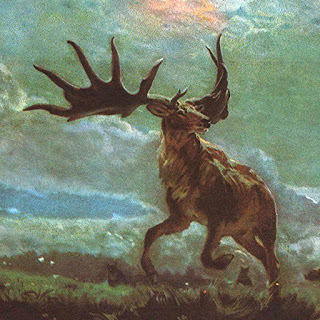 Spectacular Megaloceros painting (© Zdenek Burian)
Spectacular Megaloceros painting (© Zdenek Burian)One of the most spectacular members of the Eurasian Pleistocene megafauna was the Irish elk Megaloceros giganteus. Formally described in 1799, it is also aptly known as the giant deer, as its largest known representatives were only marginally under 7 ft tall at the shoulder and bore massive antlers spanning up to 12 ft, but did this magnificent species linger on into historic times?
Below is an account of mine devoted to this tantalising subject and dating back to 1995, when it appeared in my book In Search of Prehistoric Survivors . It is followed by various fascinating updates, including some significant palaeontological discoveries made since my book's publication but of great pertinence to the question of post-Pleistocene survival for this species.
But first – here is the relevant excerpt from my book:
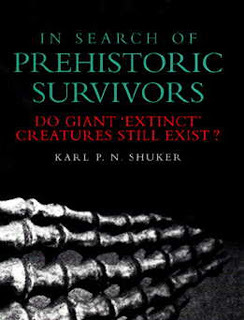
The Irish elk Megaloceros giganteus was one of the largest species of deer that ever lived. It was also one of the most famous - on account of the male's enormous antlers, attaining a stupendous span of 12 ft and a weight of over 100 lb in some specimens. Sadly, its common name is misleading, as this impressive species is only very distantly related to the true elk (moose), and, far from being an Irish speciality, was prevalent throughout the Palaearctic Region, from Great Britain to Siberia and China.
Nonetheless, it is to Ireland that we must turn for the majority of clues regarding Megaloceros- because in contradiction to the accepted view that it died out here 10,600-11,000 years ago (just prior to the Holocene's commencement), certain accounts and discoveries from the Emerald Isle have tempted researchers to speculate that this giant deer may still have been alive here a mere millennium ago.
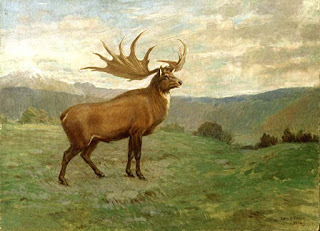 Restoration of the Irish elk, prepared in 1906 by Charles R. Knight (public domain)
Restoration of the Irish elk, prepared in 1906 by Charles R. Knight (public domain)According to accounts documented by H.D. Richardson in 1846, and reiterated by Edward Newman in the pages of The Zoologist, the ancient Irish used to hunt an extremely large form of black deer, utilising its skin for clothing, its flesh for food, and its milk for the same purposes that cow milk is used today. Supporting that remarkable claim is a series of bronze tablets discovered by Sir William Betham; inscribed upon them are details of how the ancient Irish fed upon the flesh and drank the milk of a great black deer.
These accounts resurfaced two decades later within an examination of the Irish elk's possible survival here into historic times by naturalist Philip Henry Gosse, in which he also documented an intriguing letter written by the Countess of Moira. Published in the Archaeologia Britannica, this letter recorded the finding of a centuries-old human body in a peat bog; the well-preserved body was completely clothed in garments composed of deer hair, which was conjectured to be that of the Irish elk.
Most interesting of all, however, was the discovery in 1846 by Dublinresearchers Glennon and Nolan of a huge collection of animal bones surrounding an island in the middle of Lough Gûr - a small lake near Limerick. Among the species represented in it was the Irish elk, but of particular note was the condition of this species' skulls. Those lacking antlers each bore a gaping hole in the forehead, which seemed to have been made by some heavy, blunt instrument - recalling the manner of slaughtering cattle and other meat-yielding domestic animals with pole-axes, still practised by butchers in the mid-to-late 1800s. Conversely, this species' antlered skulls (one equipped with immensely large antlers) were undamaged.
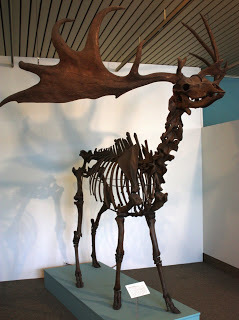 Irish elk skeleton (Wikipedia/GNU General Public License)
Irish elk skeleton (Wikipedia/GNU General Public License)Did this mean that the antler-less (i.e. female) Irish elks had actually been maintained in a domestic state by man in Ireland, as an important addition to his retinue of meat-producing species? Prof. Richard Owen sought to discount such speculation by stating that the mutilated skulls were in reality those of males, not females, and that the holes had resulted from their human killers wrenching the antlers from the skulls.
However, this was swiftly refuted by Richardson, whose experiments with fully-intact skulls of male Irish elks showed that when the antlers were wrenched off they either snapped at their bases, thereby leaving the skulls undamaged, or (if gripped at their bases when wrenched) ripped the skulls in half. On no occasion could he obtain the curious medially-sited holes exhibited by the Lough Gûr specimens. Clearly, therefore, these latter skulls were from female deer after all, explaining their lack of antlers - but what of the holes?
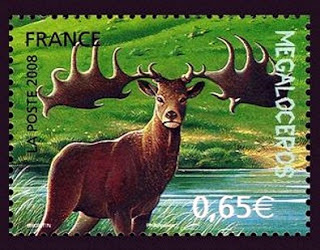 Irish elk depicted on a postage stamp issued by Francein 2008 (© French Philatelic Bureau)
Irish elk depicted on a postage stamp issued by Francein 2008 (© French Philatelic Bureau)As Gosse noted in his coverage of Richardson's researches, it is significant that the skulls of certain known meat-yielding mammals present alongside the Megalocerosskulls at Lough Gûr had corresponding holes - and as Gosse very reasonably argued: "As it is evident that their demolition was produced by the butcher's pole-ax, why not that of the elk skulls?".
After presenting these and other accounts, Gosse offered the following conclusion:
"From all these testimonies combined, can we hesitate a moment in believing that the Giant Deer was an inhabitant of Ireland since its colonisation by man? It seems to me that its extinction cannot have taken place more than a thousand years ago. Perhaps at the very time that Caesar invaded Britain, the Celts in the sister isle were milking and slaughtering their female elks, domesticated in their cattle-pens of granite, and hunting the proud-antlered male with their flint arrows and lances. It would appear that the mode of hunting him was to chase and terrify him into pools and swamps, such as the marl-pits then were; that, having thus disabled him in the yielding bogs, and slain him, the head was cut off, as of too little value to be worth the trouble of dragging home...and that frequently the entire carcase was disjointed on the spot, the best parts only being removed. This would account for the so frequent occurrence of separate portions of the skeleton, and especially of skulls, in the bog-earth."
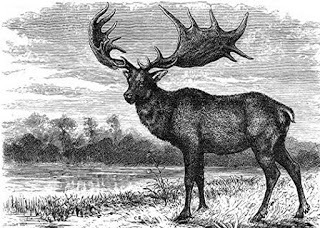 19th-Century engraving of an Irish elk (public domain)
19th-Century engraving of an Irish elk (public domain)Although undeniably thought-provoking, the case of Megaloceros's persistence into historic times in Ireland as presented by the above-noted 19th Century writers has never succeeded in convincing me - for a variety of different reasons.
For instance, there is no conclusive proof that the large black deer allegedly hunted by the ancient Irish people really were surviving Megaloceros. Coat colour in the red deer Cervus elaphus is far more variable than its common name suggests; and, as is true with many other present-day species of sizeable European mammal, specimens of red deer dating from a few centuries ago or earlier tend to be noticeably larger than their 20th Century counterparts.
Similarly, the Lough Gûr skulls' ostensibly significant contribution to this case rests upon one major, fundamental assumption - that they are truly the skulls of Megalocerosspecimens. But are they? Precise identification of fossil remains is by no means the straightforward task that many people commonly believe it to be.
 Reconstruction of an Irish elk at Ulster Museum(© Bazonka/Wikipedia)
Reconstruction of an Irish elk at Ulster Museum(© Bazonka/Wikipedia)Perhaps the greatest of all mysteries associated with this case, however, is that subsequent investigations of Megaloceros survival in Holocene Ireland as specifically inspired by the researches of Gosse and company, and formally documented in the scientific literature, are conspicuous only by their absence. (In September 1938, A.W. Stelfox of Ireland's National Museum, in Dublin, did consider this subject, but without reference to any of the above accounts.) Yet if the case for such survival is really so compelling and conclusive, how can this investigative hiatus be accounted for?
Seeking an explanation for these assorted anomalies, I consulted mammalian palaeontologist Dr Ian Lister at UCL [University College London] - who has a particular interest in Megaloceros. Confirming my own suspicions, Dr Lister informed me that it is not unequivocally established that the female Lough Gûr skulls were from Megaloceros specimens, and he suggested that they might be those of female Alces alces, the true elk or moose, which did exist in Ireland for a time during the Holocene (though it is now extinct there). Certainly in general form and size, female Alces skulls seem similar to the Lough Gûr versions.
In contrast, Lister agreed that the enormous size of the antlers borne by the male Lough Gûr skulls indicated that these were bona fide Megaloceros skulls; but as he also pointed out, although their presence in the same deposits as the remains of known domesticated species is interesting, without careful stratigraphical evidence this presence cannot be accepted as conclusive proof of association between Megaloceros and man.
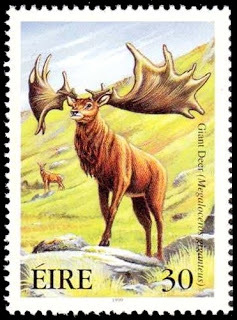 Irish elk depicted on a postage stamp issued by the Republic of Ireland (Eire) in 1999 (© An Post)
Irish elk depicted on a postage stamp issued by the Republic of Ireland (Eire) in 1999 (© An Post)During his Megaloceros account, Gosse included some reports describing discoveries in Ireland of huge limb bones assumed to be from Megaloceros, which were so well-preserved (and hence recent?) that the marrow within them could be set alight, and thereby utilised as fuel by the peasantry, or even boiled to yield soup!
Yet once again, as I learnt from Dr Lister, these were not necessarily Megalocerosbones - especially as the limb bones of red deer, moose, and even cattle are all of comparable shape and form, and can only be readily distinguished from one another by osteological specialists (who do not appear to have been granted the opportunity to examine the bones in those particular 19th Century instances, and the bones were not preserved afterwards). Furthermore, on those occasions when exhumed bones used for fuel purposes have been professionally examined, none has been found to be from Megaloceros.
In conclusion: far from being proven, the case for post-Pleistocene survival of Megalocerosin Ireland is doubtful to say the least. Nevertheless, this is not quite the end of the trail. As noted by zoologist Dr Richard Lydekker, and more recently by palaeontologist Prof. Bjorn Kurten, the word 'Schelk', which occurred in the famous Nibelungenlied (Ring of the Nibelungs) of the 13th Century, has been considered by some authorities to refer to specimens of Megalocerosalive in Austria during historic times; other authorities, conversely, have suggested that a moose or wild stallion is a more plausible candidate.
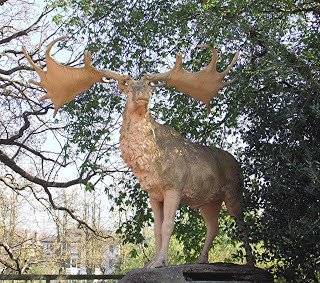 Irish elk statue at Crystal Palace, London, originally created by Benjamin Waterhouse Hawkins during the 1850s (© Dr Karl Shuker)
Irish elk statue at Crystal Palace, London, originally created by Benjamin Waterhouse Hawkins during the 1850s (© Dr Karl Shuker)Whatever the answer to the above proves to be, far more compelling evidence for such survival was presented in 1937 by A. Bachofen-Echt of Vienna. He described a series of gold and bronze engravings on plates from Scythian burial sites on the northern coast of the Black Sea. Dating from 600-500 BC and now housed at the Berlin Museum, the engravings are representations of giant deer-like creatures, whose antlers are accurate depictions of Megaloceros antlers! Undeniable evidence at last for Holocene survival?
The enigma of these engravings has perplexed palaeontologists for decades, but now a notable challenge to their potential significance has been put forward by Dr Lister, who has provided a convincing alternative explanation - postulating that the engravings were not based upon living Megaloceros specimens, but rather upon fossil Megaloceros antlers, exhumed by the Bronze Age people. This interpretation is substantiated by the stark reality that out of the hundreds of Holocene sites across Europe from which fossil remains have been disinterred, not a single one has yielded any evidence of Megaloceros.
True, absence of uncovered Holocene remains of Megaloceros does not deny absolutely the possibility of Holocene persistence (after all, there are undoubtedly many European fossil sites of the appropriate period still awaiting detection and study). Yet unless some such finds are excavated, it now seems much more likely that, despite the optimism of Gosse and other Victorian writers, this magnificent member of the Pleistocene megafauna failed to survive that epoch's close after all, like many of its extra-large mammalian contemporaries elsewhere.
That was where the matter stood back in 1995 – but not any longer!
 Irish elk lithograph from 1895 (public domain)
Irish elk lithograph from 1895 (public domain)On 15 June 2000, a paper published in the scientific journal Natureand co-authored by Dr Lister revealed that a near-complete Megaloceros skeleton uncovered in the Isle of Man (IOM) and a fragmentary antler from southwest Scotland had recently been shown via radiocarbon dating to be only a little over 9000 years old, i.e. dating from just inside the Holocene epoch – the first unequivocal proof that this mighty deer did indeed survive beyond the Pleistocene.
Intriguingly, however, as also disclosed in this paper, the Isle of Man's Holocene specimen's skeleton was statistically smaller (by over two standard deviations from its mean) than all Irish Pleistocene counterparts also measured in this study, indicating a diminution in body size for Megaloceros as it entered the Holocene, at least on the Isle of Man. Conversely, the antlers for this specimen and also the Scottish antler were well within the Irish size range for adult males.
The Isle of Manseparated from the British mainland around 10,000 years ago. Consequently, it may be that the decrease in body size recorded for the IOM specimen measured in this study (if typical and not merely a freak specimen) is a result of this island's relatively small size rather than a strictly chronological effect.
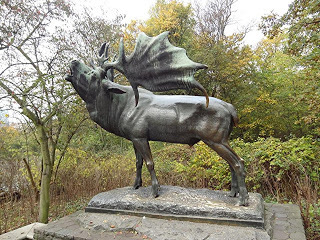 Irish elk statue at Berlin's Tierpark (© Markus Bühler)
Irish elk statue at Berlin's Tierpark (© Markus Bühler)But that is not all. On 7 October 2004, once again via a Nature paper, a team of researchers that included Dr Lister revealed via radiocarbon dating of uncovered skeletons that Megaloceros survived in western Siberia until at least circa 5000 BC, i.e. some 3000 years after the ice-sheets receded. Age-wise, these are currently the most recent Megalocerosspecimens on record, and demonstrate that the Irish elk existed during the Holocene in two widely separate localities.
So who knows? Following these exciting finds, perhaps other Holocene specimens, and possibly some of even younger dates than those presently documented, are still awaiting scientific unfurling?
Also of note is that on 8 June 2015, the journal Science Reports published a paper from a research team co-headed by Dr Johannes Krause revealing that Megalocerosremains recovered from cave sites in the Swabian Jura (Baden-Württemberg, southern Germany) dated to 12,000 years ago. Until now, it had been believed that this giant deer species had become extinct in Central Europe prior to, rather than after, the Ice Age. Moreover, the DNA techniques used in identifying the remains as Megaloceros showed that this species is actually more closely related to the fallow deer Dama dama (as long believed in the past) than the red deer (as more recently assumed).
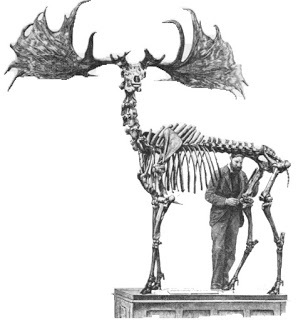 Early photograph of an Irish elk skeleton (public domain)
Early photograph of an Irish elk skeleton (public domain)One final Megaloceros mystery: On 4 July of this year (2015), Hungarian cryptozoological blogger Orosz István posted a short but very interesting item about a supposed mythological beast that I had never heard of before – the hippocerf (a name combining the Greek for 'horse' with a derivation from the Latin for 'deer'). He stated that it was said to be half horse, half deer (hence its name) and, of particular interest, that some (unnamed) researchers believed that it was based upon a Megalocerospopulation surviving into historic times. Orosz had obtained his information from a brief entry on this creature that appears on the Cryptidz.Wikia.Com website.
Needless to say, I soon conducted some online research myself concerning this intriguing creature, but I was not exactly cheered by my findings. With the exception of the above-noted Cryptidz Wikia site and a few others giving only the barest information repeated one to another ad nauseam, plus some imaginative illustrations of it created by various artists on the deviantart.com site, the hippocerf seemed to be endemic to fantasy fighting and other fantasy-style game sites. On these sites, some of the fabulous creatures featured are bona fide mythological beasts but others are complete inventions, dreamed up exclusively for the games, with no basis whatsoever in world mythology. Hence I began to suspect that the hippocerf might be in the latter category, i.e. conceived entirely for fantasy fighting games.
Indeed, apart from its very frequent appearances in Final Fantasy and other fantasy game sites and its popularity as a subject for drawing/painting on deviantart, all that I have been able to trace about the hippocerf online is that it supposedly has the hindquarters of a horse and the forequarters, neck, and antlered head of a deer, and that because of its dual nature, in heraldry it represents indecision or confusion. However, I have yet to find any confirmation of this claim from standard sources on heraldry online or elsewhere (I own several major works on this subject, and none contains any mention of the hippocerf). Nor have I uncovered the names of any of the researchers who have purportedly suggested that this distinctive creature may have derived from Megaloceros sightings in historic times. As for a claim repeated on several websites that the last known hippocerf sighting was in around 600 AD by an early archaeologist called Gregor Ishlecoff, I traced this to a book entitled The Destineers' Journal of Fantasy Nations, authored by N.A. Sharpe and Bobby Sharpe, and self-published in 2009, which proved to be a fantasy novel aimed at teenagers! I also own a considerable number of bestiary-type books on mythological beasts, and again not one of them contains any information regarding the hippocerf.
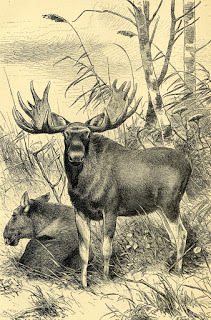 A pair of moose, depicted in an illustration from 1900 (public domain)
A pair of moose, depicted in an illustration from 1900 (public domain)In short, not very promising at all for the supposed reality of the hippocerf as a genuine (rather than a made-up) mythological beast. The only hope for its credibility is if a mention can be traced in an authentic bestiary pre-dating the coming of the internet and fantasy gaming (preferably one of the classic works from medieval or Renaissance times), or in some authoritative work on heraldry. If either or both of these possibilities result in positive info emerging, then it may be that the hippocerf was inspired by the imposing and somewhat equine form of the moose (which inhabited much of Central Europe until hunted into extinction in many parts there by the onset of the Middle Ages). To my mind, this seems like a more plausible option than the survival of Megaloceros into historic times in Europe (i.e. into much more recent times than even the circa 7000 BC date currently known for it there).
Having said that: I can't help but recall a certain noteworthy line from the Krause et al. paper of 8 June 2015 regarding the finding of post-Ice Age Megalocerosremains in Germany: "The unexpected presence of Megaloceros giganteus in Southern Germany after the Ice Age suggests a later survival in Central Europe than previously proposed". Interesting…
If anyone reading this present ShukerNature blog article has information on the hippocerf derived directly from heraldic or bestiary-type sources pre-dating the internet and fantasy-type gaming, I'd greatly welcome details.
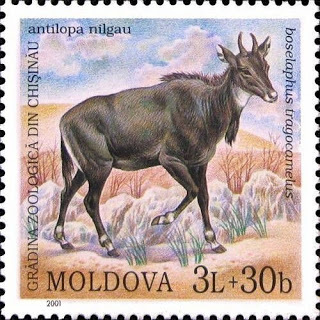 Male nilghai depicted on a postage stamp issued in 2001 by Moldova(public domain)
Male nilghai depicted on a postage stamp issued in 2001 by Moldova(public domain)Incidentally, the hippocerf should not be confused with the hippelaphos (whose name also translates as 'horse-deer', but from the Greek for 'horse' and the Greek for 'deer'), which is a genuine creature of classical mythology.
Attempts to identify it with known animal species have been made down through the ages by many authorities, including Aristotle (whose account of it recalls a gnu), Cuvier (the Asian sambar deer Rusa unicolor), and 19th-Century German zoologist Prof. Arend F.A. Wiegmann (the Indian nilghai Boselaphus tragocamelus).
Another possibility is Africa's roan antelope Hippotragus equinus, a decidedly horse-like species, as emphasised by its taxonomic binomial, as well as by its French name, Antelope Chevaline ('horse-like antelope').
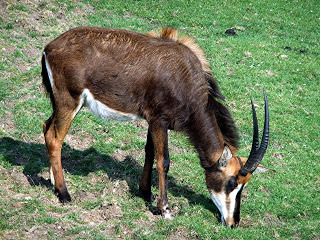 A very horse-like specimen of the roan antelope (© Dr Karl Shuker)
A very horse-like specimen of the roan antelope (© Dr Karl Shuker)This ShukerNature blog article is an updated excerpt from my book In Search of Prehistoric Survivors .
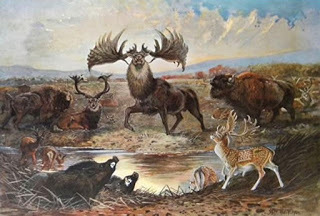 'In the Meadows – Pleistocene Age' – an adult male Irish elk taking centre-stage in this stunning painting from 1904 by John Guille Millais (public domain)
'In the Meadows – Pleistocene Age' – an adult male Irish elk taking centre-stage in this stunning painting from 1904 by John Guille Millais (public domain)
Published on July 05, 2015 16:38
July 4, 2015
GLOBSTERS ABOUNDING! - PART 2: SEEKING GIANT OCTOPUSES… BUT FINDING ROTTING SPERM WHALES
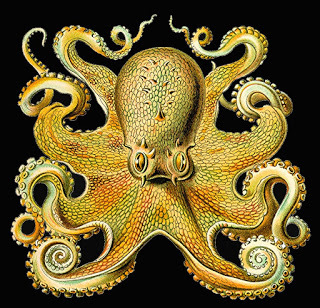 Vintage illustration of a deepsea octopus, by Ernst Haeckel (public domain)
Vintage illustration of a deepsea octopus, by Ernst Haeckel (public domain)In Part 1 of this ShukerNature blog article (click here ), I surveyed a wide range of globsters, including the celebrated Trunko, and I also chronicled a selection of reports featuring alleged giant octopuses – traditionally, the most popular identity for globsters. As now revealed, however, modern-day studies of these latter anomalous entities have unveiled a very different explanation for them.
UNMASKING THE GLOBSTERS, AND UNVEILING THE QUASI-OCTOPUSThanks to the advances in DNA technology during the past two decades, science now has a reliable tool with which to investigate and expose the hitherto-cryptic identity of globsters, and in the past few years this is precisely what has happened, with eye-opening results.
The first notable globster to be unmasked by DNA analyses was the Fortune Bay specimen from Newfoundland. In February 2002, a team of researchers led by Newfoundland molecular systematics expert Dr Steven M. Carr published their findings in the Biological Bulletin scientific journal, summarising them as follows:
"DNA was extracted from the carcass and enzymatically amplified by the polymerase chain reaction (PCR): the mitochondrial NADH2 DNA sequence was identified as that of a sperm whale (Physeter catodon). Amplification and sequencing of cryptozoological DNA with "universal" PCR primers with broad specificity to vertebrate taxa and comparison with species in the GenBank taxonomic database is an effective means of discriminating otherwise unidentifiable large marine creatures."
Effective it has certainly been. One South Florida scientist with a longstanding interest in globsters is Dr Sidney K. Pierce, and in recent years he has led several studies of preserved globster remains, culminating in a detailed Biological Bulletin paper of June 2004 co-authored by Carr and several other researchers, which concentrated upon the Chilean globster but also examined samples from various additional specimens.
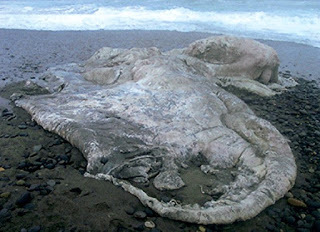 Chilean globster (© Dr Elsa Cabrera – Fair Use/Educational Purposes Only)
Chilean globster (© Dr Elsa Cabrera – Fair Use/Educational Purposes Only)The team announced:
"Electron microscopy revealed that the remains [of the Chilean globster] are largely composed of an acellular, fibrous network reminiscent of the collagen fiber network in whale blubber. Amino acid analyses of an acid hydrolysate indicated that the fibers are composed of 31% glycine residues and also contain hydroxyproline and hydroxylysine, all diagnostic of collagen. Using primers designed to the mitochondrial gene nad2, an 800-bp product of the polymerase chain reaction (PCR) was amplified from DNA that had been purified from the carcass. The DNA sequence of the PCR product was 100% identical to nad2 of sperm whale (Physeter catodon). These results unequivocally demonstrate that the Chilean Blob is the almost completely decomposed remains of the blubber layer of a sperm whale. This identification is the same as those we have obtained before from other relics such as the so-called giant octopus of St. Augustine (Florida), the Tasmanian West Coast Monster, two Bermuda Blobs, and the Nantucket Blob. It is clear now that all of these blobs of popular and cryptozoological interest are, in fact, the decomposed remains of large cetaceans."
Yet how can a decomposed sperm whale transform in shape and texture so dramatically that it becomes a globster, sometimes even equipped with apparent tentacles? As I revealed in my book, Extraordinary Animals Revisited (2007), the answer is fascinating, and also has a notable precedent:
"There is a notable precedent for such dramatic misidentification when dealing with beached remains, which is known as the pseudo-plesiosaur effect. When a basking shark Cetorhinus maximus dies and its body decomposes, it undergoes a remarkable transformation. The gill apparatus falls away, taking with it the shark's jaws, leaving only its small cranium and exposed backbone, thus resembling a small head and long neck. The end of the shark's backbone only runs into the upper fluke of its tail, so during decomposition the lower fluke falls off, leaving what looks like a long slender tail. And to complete the plesiosaur deception, the shark's pectoral fins, and sometimes its pelvic fins too, remain attached, resembling two pairs of flippers. Little wonder, therefore, why a number of amazingly plesiosaurian carcases have been reported over the years, only for anatomical and biochemical analyses to expose them as sharks.
"Now, moreover,we have confirmation that an analogous transformation is responsible for at least some of the hitherto perplexing globsters that have come to light - a transformation that I propose should hereafter be referred to as the quasi-octopus effect. As detailed by Drs Pierce, Carr, and Letelier, after a whale dies its body can float for months, decomposing, until eventually its heavy backbone and skull dissociate from their encompassing skin-sac of rotting blubber, and sink to the sea bottom, leaving behind a thick gelatinous matrix of collagen - the tough protein found in skin and connective tissue. It is this mass of collagen, still encased in its skin-sac, that washes ashore, as a globster. Furthermore, if a few of the whale's ribs remain within the collagen matrix, and any 'fingers' of fibrous flesh are attached to them, these resemble tentacles [or even a trunk, in the case of Trunko]. And if the whale is a sperm whale, the spermaceti organ gives the resulting globster a bulky shape reminiscent of an octopus."
So does that mean that globsters are a dead-end as far as providing evidence for the reality of giant octopuses is concerned? Not quite, perhaps...
VERRILLY A GIANT OCTOPUS?The grand-daddy of all globsters was washed ashore near St Augustine, Florida, on 30 November 1896. Its prodigious remains, pinkish-grey and pear-shaped, were over 6 m long, 1.6 m wide, and 1.3 m high, and were estimated to weigh 5 tons. What appeared to be the stumps of five massive tentacles were clearly visible in photographs taken of this monstrous carcase by local physician DeWitt Webb, as was what seemed to be a severed tentacle, measuring 8.7 m long and 20 cm thick. Webb sent a sample of its tough flesh to Yale University cephalopod (squid and octopus) expert Prof. Addison E. Verrill, who announced that the carcase had been a giant octopus, which he formally christened Octopus giganteus. Later, however, Verrill recanted, claiming that it was merely the spermaceti organ of a sperm whale.
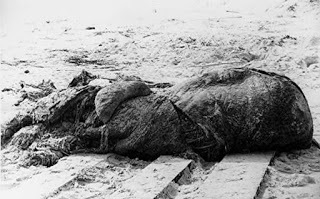 St Augustine globster (public domain)
St Augustine globster (public domain)A second sample, sent to the Smithsonian Institution, has been tested on numerous occasions via several different techniques, and has yielded differing results. Whereas Pierce’s studies indicated that it was indeed of sperm whale origin, analyses by eminent Chicago University biochemist and longstanding cryptozoological investigator Prof. Roy P. Mackal strongly supported an octopus identity. However, the sample has been preserved for so long that it has probably been contaminated and rendered useless for detailed study - which would explain the greatly diverging results - unless future advances in technology can overcome this obstacle. If they can, then interested researchers should apply to the Institute of Creation Research (ICR) in El Cajon, California, for it is here that the only surviving sample of tissue from the St Augustine globster can be found, donated by Prof. Mackal in 2003 to the ICR’s Professor of Biology, Dr Kenneth Cummings.
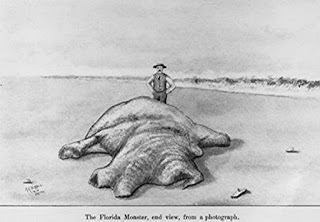 Drawing of St Augustine globster by Prof. Addison E. Verrill (public domain)
Drawing of St Augustine globster by Prof. Addison E. Verrill (public domain)How ironic it would be if the existence or otherwise of what would be (if real) one of the largest marine creatures alive today – the elusive giant octopus – is ultimately determined by this tiniest sliver of substance, the last remnant from one of cryptozoology’s most enduring enigmas. For a further picture and details concerning this globster, click here to access my ShukerNature-reprinted interview conducted back in the 1990s with Prof. Mackal.
THE MULTI-LIMBED MONSTER OF ANTIBESIn addition: A truly bizarre sea monster was allegedly sighted between Antibes and Nice in 1562. Oval in shape, with a pig’s head at one end and a trunked elephant-like head at the other, it boasted no less than eleven claw-bearing limbs.
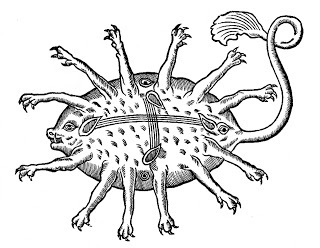 Antibes multi-limbed sea monster (public domain)
Antibes multi-limbed sea monster (public domain)Is it possible that this weird entity, depicted in the Paralipomena (supplement) to the second edition of Conrad Gesner’s Historiae Animalium Liber IV: Piscium et Aquatilium Animantium Natura (1604), was a distorted description of a giant octopus?
GIANT OCTOPUS, OR MYSTERYJELLYFISH?Finally: In 1953, while testing a new type of deep-sea diving suit in the South Pacific, an Australian diver encountered a Lovecraftian horror from the ocean’s unpenetrated depths, which I documented as follows within my book From Flying Toads To Snakes With Wings (1997):
"The diver had been following a shark, and was resting on the edge of a chasm leading down to much deeper depths, still watching the shark, when an immense, dull-brown, shapeless mass rose up out of the chasm, pulsating sluggishly, and flat in general outline with ragged edges.
"Despite appearing devoid of eyes or other instantly-recognizable sensory organs, this malign presence evidently discerned the shark's presence somehow, because it floated upwards until its upper surface made direct contact. The shark instantly gave a convulsive shudder, and was then drawn without resistance into the hideous monster's body. After that, the creature sank back down into the chasm, leaving behind a very frightened diver to ponder what might have happened if that nightmarish, nameless entity had not been attracted towards the shark!"
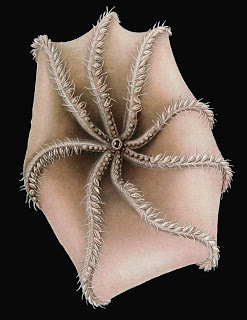 Cirrothauma murrayi
, a species of deepsea cirrate octopus (public domain)
Cirrothauma murrayi
, a species of deepsea cirrate octopus (public domain)In the past, a deepsea octopus has been offered as a possible identity for this disturbing creature, but as I discussed in detail within my book, a far more satisfactory candidate is a deepsea jellyfish.
Whereas all octopuses have tentacles, some deepsea jellyfishes do not. What they do have, however, are potent stinging cells called nematocysts on their bodies (and tentacles if they possess any), armed with venom that swiftly paralyses their prey. This would readily explain the immediate paralysis of the shark. Moreover, jellyfishes do not possess true eyes but they are equipped with sensory structures responsive to water movements. Consequently, the creature would have learnt of the shark’s presence by detecting its movements in the water. How lucky, then, that the diver had remained stationary!
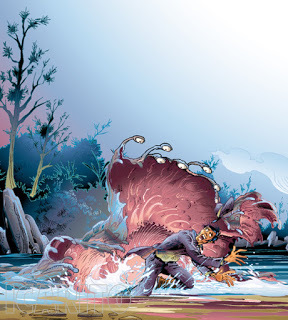 Artistic representation of the deadly Chilean hide (© Icarito)
Artistic representation of the deadly Chilean hide (© Icarito)Interestingly, Chilean legends tell of a very similar beast called el cuero or the hide, as it is likened in shape and size to a cowhide stretched out flat, with countless eyes around its perimeter, and four larger ones in the centre. As it happens, jellyfishes possess peripheral sensory organs called rhopalia that incorporate simple light-sensitive eyespots or ocelli.
Moreover, some jellyfishes also have four larger, deceptively eye-like organs visible at the centre of their bell, though in reality these organs are not eyes at all. Instead, they are actually portions of the jellyfishes' gut, known as gastric pouches, with the jellyfishes' horseshoe-shaped gonads sited directly underneath these pouches and also very visible (as in the familiar moon jellyfish Aurelia aurita).
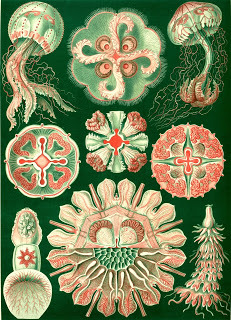 Exquisite illustration of various jellyfish species revealing their four centrally-sited gastric pouches, depicted by Ernst Haeckel (public domain)
Exquisite illustration of various jellyfish species revealing their four centrally-sited gastric pouches, depicted by Ernst Haeckel (public domain)So perhaps the deadly hide is more than a myth after all, lurking like so many other maritime horrors reported down through the ages in the deep oceans' impenetrable black abyss, but only very rarely encountered by humankind – which in view of the dreadful fate that befell the hapless South Pacific shark in 1953 may be just as well!
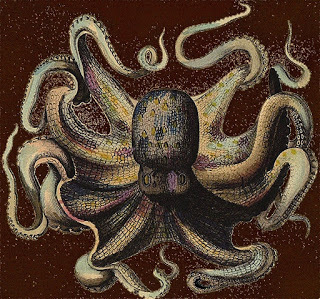 A sinister-looking deepsea octopus in a 19th-Century illustration (public domain)
A sinister-looking deepsea octopus in a 19th-Century illustration (public domain)For further details concerning globsters and Trunko, check out my books Extraordinary Animals Revisited and Mirabilis .

Published on July 04, 2015 16:10
GLOBSTERS ABOUNDING! - PART 1: BLOBS, TRUNKO, LUSCA, AND MORE...
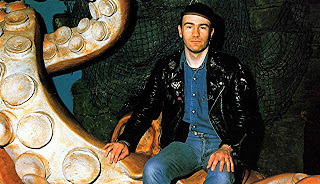 Me with giant octopus model (© Dr Karl Shuker)
Me with giant octopus model (© Dr Karl Shuker)Mystery beasts come in all sizes and shapes, but in the case of globsters they are most famous not just for their great size but also for their conspicuous lack of any well-defined shape. Aptly named by American cryptozoologist Ivan T. Sanderson in the early 1960s, globsters (also dubbed blobsters or blobs) are generally huge, amorphous masses of decomposing tissue, usually rubbery and covered in fibrous ‘hair’, lacking any recognisable body parts or skeleton, which are regularly washed ashore on beaches around the world.
GLOBSTERS IN THE NEWSThe first globster to attract international attention, and for which Sanderson coined the term ‘globster’, was discovered on the beach north of Tasmania’s Interview River by three eyewitnesses in August 1960. Measuring about 6 m long, 5.5 m wide, and 1.2 m thick, with an estimated weight of 5-10 tonnes, it was composed of tendon-like threads attached to a fatty substance that did not readily compose. Despite its unusual appearance, it was left uninspected on the beach for over 18 months until some on-site tests were finally conducted on 7 March 1962 by Australia’s CSIRO (Commonwealth Scientific and Industrial Research Organisation), which proved inconclusive. A second CSIRO analysis 10 days later revealed protein and in particular the connective tissue protein collagen to be primary constituents.
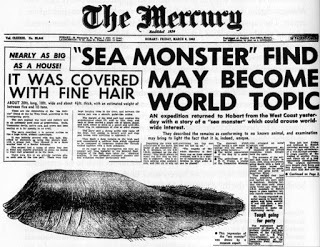 Newspaper cutting re the Tasmanian globster of 1960 (© Hobart Mercury)
Newspaper cutting re the Tasmanian globster of 1960 (© Hobart Mercury)In 1965, another hairy globster, 9 m long, was found on a New Zealand beach, and a smaller one, only 2.5 m long, turned up in November 1970 on a Tasmanian beach. More recently, Tasmania hosted yet another globster stranding when in January 1998 a 6-m, 4-ton specimen drifted ashore on Four Mile Beach. What made this example particularly interesting was that it sported several sturdy, elongate projections resembling tentacles.
 Four Mile Beach globster as documented in the globster coverage from my book
Mysteries of Planet Earth
(© Dr Karl Shuker/Carlton Books/globster photo's copyright owner unknown to me – please post details if known)
Four Mile Beach globster as documented in the globster coverage from my book
Mysteries of Planet Earth
(© Dr Karl Shuker/Carlton Books/globster photo's copyright owner unknown to me – please post details if known)Another tentacled enigma was the stranded globster spied by tourist Louise Whipps (not Whitts, as frequently but incorrectly given in media reports) on Benbecula, a small remote Scottish island in the Outer Hebrides. Until now, Benbecula’s claim to cryptozoological fame had been the burying here more than 170 years earlier of a supposed mermaid, but whatever the putrefying entity encountered by Whipps had once been, it had definitely never been a mermaid. A photo of her sitting beside the globster provided a useful scale that confirmed her estimation of its length - a relatively modest 3.5 m.
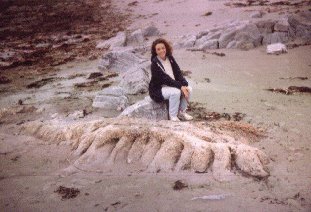 Louise Whipps with the Benbecula globster (© Louise Whipps – Fair Use/Educational Purposes Only)
Louise Whipps with the Benbecula globster (© Louise Whipps – Fair Use/Educational Purposes Only)What made the Benbecula specimen unexpectedly eyecatching (for a globster!), however, was the series of tentacular flaps that fringed its otherwise flat, elongate form. Staff at Newcastle’s Hancock Museum, shown Whipps’s photo, were unable to offer any positive identification of this globster, and despite the photo later appearing in countless media reports worldwide, it remained unidentified.
Equally well-publicised was the so-called Bermuda blob - a grey 2.5-m rubbery specimen discovered washed up on a beach in Mangrove Bay, Bermuda, by Teddy Tucker during May 1988. Waves subsequently washed it back out to sea, but not before Tucker had removed a chunk of its flesh and preserved it in formalin.
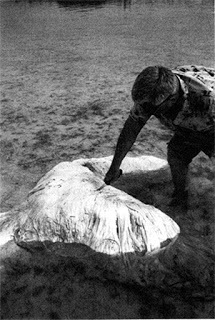 Teddy Tucker with the 1988 Bermuda blob (© Teddy Tucker – Fair Use/Educational Purposes Only)
Teddy Tucker with the 1988 Bermuda blob (© Teddy Tucker – Fair Use/Educational Purposes Only)Tissues samples were also obtained from the globster cast up from the depths in August 2001 at St Bernard’s, Fortune Bay, in Newfoundland, as well as from the most famous globster of modern times – the enormous gelatinous specimen discovered washed ashore on 23 June 2003 by a crowd of perplexed coastal villagers from Los Muermos, southern Chile. Measuring a stupendous 12.5 m long, 5.6 m wide, 1 m high at its tallest point, and estimated to weigh over a tonne, like most globsters it was wholly shapeless in form, leathery in texture, and grey and pink in colour, inspiring some news reports to liken it to a squashed elephant! With such a vast quantity of tissue available, it is heartening to learn that samples were indeed taken for scientific testing.
GLOBSTERISING TRUNKOPerhaps the most sensational globster revelation of modern times, however, came in 2010, when, following our joint discovery of some remarkable photographs published more than 80 years earlier but which had hitherto remained entirely unknown to the cryptozoological world, I and German cryptozoologist Markus Hemmler exclusively revealed that one of the world's most anomalous and contentious mystery beasts had in fact been a globster. The cryptid in question was none other than Trunko – the huge sea monster sporting a long proboscis-like structure and covered in what eyewitnesses described as snow-white fur that was washed ashore on a South African beach during the early 1920s, remaining there for several days before the tide carried it back out to sea, never to be seen again, or identified – until 2010, that is.
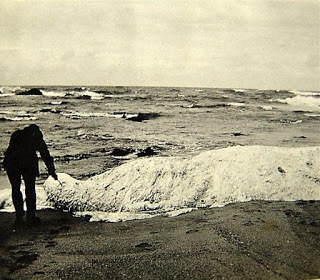 Trunko (© A.C. Jones)
Trunko (© A.C. Jones)Following a close examination of the excellent, newly-unearthed close-up photos, however, which had been snapped by one of Trunko's eyewitnesses and published shortly afterwards in a magazine article that had, astonishingly, been overlooked completely by cryptozoologists for more than eight decades afterwards, I could see beyond any shadow of doubt that what they depicted was an absolutely typical (indeed, classic) globster. In other words, the Trunko carcase was not that of some extraordinary maritime elephant whose species still eluded science, as had been seriously speculated in the past, but was actually something much more prosaic, the same as all other globsters – whose precise nature will be revealed a little later in this present ShukerNature blog article.
For full details of Trunko's long-awaited identification and resolution, click here , here , and here , and also see my definitive chapter-length account in my book Mirabilis (2013).
Clearly, there is no shortage of globsters on record – but what exactly are they? Resembling no known species, they have been the subject of heated zoological and cryptozoological debate for decades – with identities ranging from some wholly unknown marine species or decomposed whales to rotting shark carcases and, most intriguing of all, the putrefied remains of gargantuan octopuses, far bigger than any currently recognised by science.
TENTACLES OF TERRORThe world’s largest known species of octopus is Enteroctopus dofleini, with a maximum recorded tentacle (or, technically, arm) span of 7.1 m. Having said that, a freakishly large specimen of Haliphron atlanticus was dredged up by a fishing trawler off New Zealand’s Chatham Islands in March 2002 that sported an estimated tentacle span of 10 m (it was an incomplete, badly-damaged individual). However, some truly gigantic octopuses that would put even the latter to shame have been reported from a number of disparate locations over the years, suggesting that science has far from confirmed the upper size limit of these mighty eight-limbed monsters of the deep.
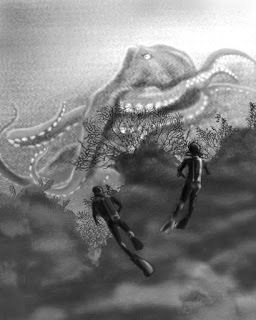 Do giant mystery octopuses exist? (© William Rebsamen)
Do giant mystery octopuses exist? (© William Rebsamen)Hawaii has a longstanding history of giant octopuses. In 1928, for instance, no less than six colossal specimens, each with an estimated tentacle span approaching 12.5 m, were allegedly sighted together off Oahu’s coast by Robert Todd Aiken, who was stationed at Pearl Harbor with the US Navy at that time. A comparable giant, greyish-brown and said to be the size of a car, with suckers as big as dinner plates along each of its 9.3-m tentacles, was seen by diver Madison Rigdon about 200 m off Oahu’s Lahilahi Peninsula one Sunday morning in 1950. The octopus was being attacked by several sharks, but succeeded in warding them off, after which it released a huge quantity of black ink and swiftly sank out of sight.
Amazingly, an even bigger octopus was reported that very same year, this time spotted by fisherman Val Ako as it rested 10 m or so underwater on a reef off Hawaii’s Kona Coast. Ako claimed that its tentacles were around 25 m long, armed with suckers as big as car tyres, and stated that it was still there half an hour after he had first sighted it.
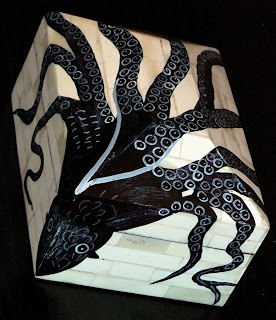 My giant octopus trinket box, inlaid with mother-of-pearl; interestingly, whether by chance or design, some of the octopus's tentacles are bifurcate (© Dr Karl Shuker)
My giant octopus trinket box, inlaid with mother-of-pearl; interestingly, whether by chance or design, some of the octopus's tentacles are bifurcate (© Dr Karl Shuker)Gargantuan octopuses have sometimes been blamed for disturbing or raiding shellfish traps placed on the seabed. One such case featured Bermudan fisherman Sean Ingham, who lost two very sizeable prawn traps to an elusive underwater plunderer between 29 August and 3 September 1984, the second of which had been snapped from its cable at a depth of 560 m. When laying some more traps 16 days later, however, he had a terrifyingly close encounter with his foe, when without warning something grabbed hold of his boat from below, and effortlessly dragged it along for more than half a kilometre before finally releasing it again. Moreover, the vessel’s sonar equipment revealed that the mysterious underwater boatnapper had been 15.5 m high and pyramidal in shape, i.e. the typical shape of an octopus, but one of gigantic proportions.
On Christmas Eve 1989, a massive octopus - “as huge as an imported cow”, according to one eyewitness, Agapito Caballero - allegedly rose to the surface and attacked a motorised canoe transporting a number of people in waters off the southern Philippines. Twelve survivors were rescued, clinging onto their overturned canoe, by some fishermen on Christmas Day. The survivors claimed that once the octopus had capsized the canoe by grabbing its outriggers, it had simply sunk back beneath the waters, without attempting to harm any of their company.
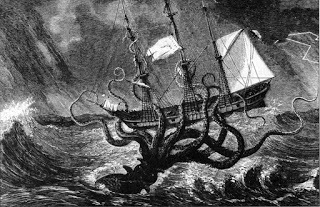 19th-Century engraving of a giant octopus attacking a ship (public domain)
19th-Century engraving of a giant octopus attacking a ship (public domain)Famous Roman naturalist Pliny the Elder (23-79 AD) claimed that a monstrous octopus with a barrel-sized head and tentacles 9 m long would come ashore and raid fish ponds in Rocadillo, Spain (octopuses are indeed known to leave water and cross land if necessary to capture prey). And as far back as classical times, giant octopuses have been reported from the Mediterranean. Indeed, the mythical many-armed, hole-dwelling sea monster Scylla has been claimed by some researchers to have been inspired by sightings of huge octopuses in Italian waters.
During his own investigations of reputed giant octopuses, veteran American marine biologist and amateur cryptozoologist Dr Forrest Wood collected several reports from the Bahamian island of Andros, whose blue holes (vertical underwater caves) are claimed by locals to be frequented by a monster known as the lusca, equipped with “hairy hands” that drag down any unwary human divers or bathers. Certain octopuses, known as cirrate octopuses, are characterised by tentacles bearing hair-like projections (cirri). Consequently, some cryptozoologists have suggested that the lusca may be an unknown species of giant cirrate octopus.
Supporting a link between lusca and giant octopus is a report given to Wood on Andros by an island inspector, who claimed that during a fishing trip off the island with his father, in waters approximately 180 m deep, their line seemed to snag on the sea bottom. When they looked down through the transparent water, however, they were aghast to see that in reality, the line had hooked an enormous octopus, which abruptly released the line and gripped the bottom of their boat instead! Fortunately, however, it soon let go, and sank down far below until it vanished from view.
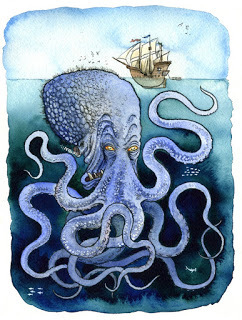 Giant octopus as conceived by Swedish crypto-artist Richard Svensson (© Richard Svensson)
Giant octopus as conceived by Swedish crypto-artist Richard Svensson (© Richard Svensson)Clearly, then, there is ample circumstantial evidence on file to suggest the existence of mega-octopuses in various expanses of water around the world – but what about globsters? Do they genuinely constitute physical evidence for these creatures’ existence?
For this and other startling revelations, be sure to check out Part 2 of this ShukerNature blog article, coming soon!
 Captain Nemo viewing a giant octopus – an illustration from the classic Jules Verne novel Twenty Thousand Leagues Under the Sea (public domain)
Captain Nemo viewing a giant octopus – an illustration from the classic Jules Verne novel Twenty Thousand Leagues Under the Sea (public domain)
Published on July 04, 2015 05:28
June 28, 2015
A SHORT HISTORY OF SEA-MONKEYS - FROM COMIC-BOOK ADVERTISEMENTS TO CRYPTOBIOTIC ARTEMIA
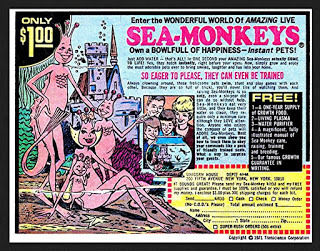 A mail-order advertisement for sea-monkeys that appeared in numerous American children's comic-books during the early 1970s - click picture to enlarge it for reading the advert (© Transcience Corporation)
A mail-order advertisement for sea-monkeys that appeared in numerous American children's comic-books during the early 1970s - click picture to enlarge it for reading the advert (© Transcience Corporation)As a child during the late 1960s and early 1970s, living in England, I enthusiastically supplemented my already-extensive reading of British comics with any American comic-books that I could find, especially ones published by Gold Key or Charlton that featured popular television cartoon characters from that time period. Moreover, browsing through them I not only enjoyed the comic strip stories themselves but also never failed to be equally captivated as well as wholly confused and thoroughly tormented in equal measure by a certain mail-order advertisement (reproduced at the beginning of this present ShukerNature blog article) that these comic-books frequently contained – captivated by the extraordinary entities that this advertisement offered for sale, yet confused by what seemed to be a self-evident fact that such entities couldn't possibly exist, and tormented because, as the comic-books were American and the mail-order advertisement required pre-payment in US dollars only ($1 plus 30c p&p), to be sent to an address in New York, USA, I couldn't readily purchase any of these entities directly myself and thence discover their true nature.
I still retain a representative selection of those comic-books from my childhood, and perusing some of them recently I was delighted to discover no fewer than three that actually contained this particular advertisement. Two of them were Tom and Jerry comic-books published by Gold Key, the issues in question being August 1972 (#265) and August 1973 (#273) respectively; the third was the November 1971 issue (#72) of Gold Key's Daffy Duck/The Road Runner comic-book.
 Holding my August 1972 issue of Gold Key's Tom and Jerry comic-book open at the page containing the sea-monkeys advertisement – click picture to enlarge it for viewing the sea-monkeys advert in close-up detail (© Dr Karl Shuker/Gold Key/Metro-Goldwyn-Mayer Inc/Transcience Corporation)
Holding my August 1972 issue of Gold Key's Tom and Jerry comic-book open at the page containing the sea-monkeys advertisement – click picture to enlarge it for viewing the sea-monkeys advert in close-up detail (© Dr Karl Shuker/Gold Key/Metro-Goldwyn-Mayer Inc/Transcience Corporation)As can be seen from this advertisement, the entities in question were referred to as sea-monkeys, and were depicted, astonishingly, as a family (father, mother, daughter, and young son) of tiny underwater-inhabiting humanoid beings, but sporting a long finned tail, normal fingered hands yet wholly webbed feet, three bauble-tipped spikes on top of their heads resembling a crown but seemingly constituting a physical part of their skull, a heavily-scaled chest in both male and female, plus a ridged back recalling that of a seahorse.
But that was not all. According to the advertisement, these incredible sea-monkeys hatched from eggs and came to life instantly when placed in water, and could even be trained to play games. Yet they allegedly required hardly any food or general maintenance, even keeping their water clean without any outside assistance.
As someone with a veritable library of wildlife books readily to hand even as a child, bought for me with great love over the years by my mother, my grandparents (my mother's parents), and my great-aunt, and whose precious information I'd hungrily devoured through time and constant re-reading in my relentless quest for ever more knowledge concerning animals (especially the more unusual ones), I was only too well aware that sea-monkeys did not feature in any of them, not by as much as a single sentence. (And because all of this took place many years before the internet was born, the world of instantly-accessible, near-infinite quantities of information that we all inhabit today – and which would surely have yielded the necessary details to solve the sea-monkey conundrum swiftly and conclusively – was nothing more than a sci-fi dream of the far-distant future back then.) So what on earth – or, more precisely, under the water – were these astonishing aquatic beings, these so-called sea-monkeys? How could they be explained?
 Close-up of the sea-monkeys as portrayed in an early 1970s mail-order advertisement (© Transcience Corporation)
Close-up of the sea-monkeys as portrayed in an early 1970s mail-order advertisement (© Transcience Corporation)Might it be that the entire super-monkey scenario was simply a hoax, I wondered – perhaps an ingenious means of enticing naïve and credulous youngsters reading the sea-monkey mail-order advertisement in their comic-books to send off money in the hope of purchasing miraculous little beings that in reality didn't exist, meaning therefore that the youngsters never received any sea-monkeys nor saw their money again either? Alternatively, I even pondered over the prospect that perhaps sea-monkeys were a novel life-form that had somehow been created artificially by scientists (having said that, please bear in mind that I was still only a child back then, and one with a very vivid imagination on top!).
It took several years, but during the mid-1970s I finally discovered the answer to the riddle of the sea-monkeys, an answer so long awaited by me. One day, I happened to spot in an American comic-book a version of the sea-monkey advertisement that I had never seen before. True, the image of the sea-monkeys was exactly the same as before, and the details concerning them were much the same too (albeit slightly reworded and presented in a somewhat different layout, and also incorporating a minor increase in required pre-payment for the sea-monkeys, from $1 to $1.25, plus 50c p&p). But what made this particular version of the advertisement so significant to me was that it contained a small yet very telling amendment.
As can be seen below in the following reproduction of this amended advertisement, a brief disclaimer was present in small print along the bottom edge of the advert, which read: "Caricatures shown not intended to depict Artemia". With those fateful words, the mystery that (at least for me) had long surrounded the sea-monkeys was instantly and comprehensively dispersed – the cat was finally out of the bag, or, to quote a more zoologically apt metaphor, the shrimps were finally in the net!
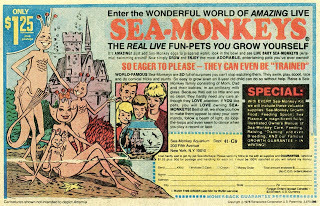 A 1976 comic-book advertisement for sea-monkeys that included a disclaimer which provided an answer to the riddle of these perplexing beings' true nature - click picture to enlarge it for reading the advert (© Transcience Corporation)
A 1976 comic-book advertisement for sea-monkeys that included a disclaimer which provided an answer to the riddle of these perplexing beings' true nature - click picture to enlarge it for reading the advert (© Transcience Corporation)For not only had the advertisement's whimsical sea-monkey illustrations been exposed by the disclaimer as being merely caricatures rather than accurate representations of these entities' true appearance, the sea-monkeys themselves had been unmasked, having been shown not to be entities in any humanoid sense of the word. Instead, as unequivocally identified in the disclaimer, they were Artemia – i.e. brine shrimps!
Veritable living fossils inasmuch as they differ very little in overall morphology from their Triassic ancestors dating back in the fossil record to over 200 million years ago, brine shrimps inhabit inland saltwater lakes (but not marine habitats) and are of worldwide distribution. Measuring little more than 1 cm in total length (females are slightly larger than males), and often pink in colour, they consist of eight separate species all housed within the single genus Artemia (of which the most familiar is A. salina), and belong to the taxonomic class of crustaceans known as branchiopods. These also include among their numbers those fellow living fossils the tadpole shrimps Triops and Lepidurus, as well as the water fleas (e.g. Daphnia), fairy shrimps, and clam shrimps.
Brine shrimps possess a typical primitive crustacean body design, composed of head, thorax, and a lengthy slender abdomen (often colloquially termed the tail), the body itself usually consisting of 19 segments, of which the first eleven (constituting the thorax) each bears a pair of broad leaf-like limbs. In addition, the long abdominal section ('tail') sports at its tip a pair of slender, vaguely fin-like structures called furcae. The head bears a pair of large laterally-sited compound eyes on stalks, plus a third medial eye that is the only eye present in brine shrimp larvae (nauplii). It also possesses two pairs of antennae (in the male, the second pair is modified into greatly-enlarged clasping organs for gripping the female during mating), and three pairs of jawparts (mandibles, maxillulae, and maxillae).
 19th-Century engraving of an adult male Artemia salina brine shrimp, revealing the composition of its body and also showing its greatly-enlarged claspers, modified from its second pair of antennae (public domain)
19th-Century engraving of an adult male Artemia salina brine shrimp, revealing the composition of its body and also showing its greatly-enlarged claspers, modified from its second pair of antennae (public domain)Yet despite the fact that, fin-bearing 'tail' notwithstanding, brine shrimps clearly look nothing whatsoever like the advertisement's delightful yet entirely fanciful sea-monkey illustrations that depict the latter entities as underwater finned humanoids, these small crustaceans do share one major, fundamental similarity with the sea-monkeys as described in this advert.
Under normal conditions, adult female brine shrimps ovulate every 140 hours, and their eggs hatch almost instantly when placed into water with favourable salinity levels (25-250 g/l, with 60-100 g/l being the optimal range, brine shrimps being able to withstand much higher salinity concentrations than most other animals). This activity validates the sea-monkey advertisement's claim that the latter's eggs will hatch as soon as placed in water – in other words, instant life (which was the original name given to sea-monkeys before their simian moniker was dreamed up – see later in this article).
But that is not all. If confronted by unfavourable salinity levels, female brine shrimps will not produce normal eggs but will instead produce metabolically-inactive ones known as cysts, which are coated externally with a protective brown-coloured covering of chorion, enabling them to remain dormant for up to 2 years, even when exposed to such extreme conditions as immersion in liquid air at temperatures as low as -190°C, or in boiling water for up to 2 hours. This ability to remain in suspended animation for a prolonged period of time is known as cryptobiosis. Once placed in favourable surroundings, however, the cysts will hatch within a few hours. Needless to say, such hardy, virtually indestructible creatures that are so easily reared make ideal pets for young children who possess little if any practical pet-keeping experience – a simple truth that ultimately inspired the whole sea-monkey concept.
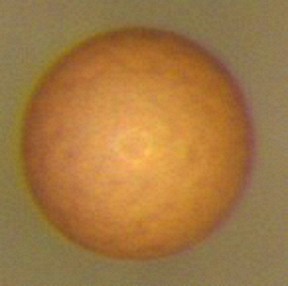 A brine shrimp cyst, in which this crustacean undergoes an extended period of suspended animation or cryptobiosis (public domain)
A brine shrimp cyst, in which this crustacean undergoes an extended period of suspended animation or cryptobiosis (public domain)In addition, brine shrimps are extremely active, energetic swimmers, another characteristic guaranteed to engage and hold the attention of youngsters. Indeed, in his famous three-volume Illustrated Natural History published in 1863, the Reverend J.G. Wood included a paragraph that perfectly captures the very lively, animated behaviour of brine shrimps, readily explaining their continuing popularity as pets for children:
"The movements of this little creature are most graceful. It mostly swims on its back, its feet being in constant motion, and its course directed by means of its long tail. It revolves in the water, bends itself into varied curves, turns fairly over, wheels to the right or left, and seems thoroughly to enjoy the very fact of existence."
Yet even after I finally discovered during the mid-1970s that sea-monkeys were actually brine shrimps, additional details concerning the sea-monkey scenario remained undisclosed to me for many years – until the internet's vast resources of online information presented me at long last with the history and background behind these most unexpected yet exceedingly popular pets, and which I am now summarising as follows.
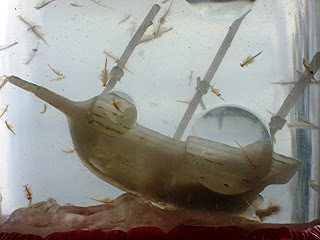 Brine shrimp 'sea-monkeys' swimming in an aquarium (public domain)
Brine shrimp 'sea-monkeys' swimming in an aquarium (public domain)Long before the advent of sea-monkeys, brine shrimp were (and still are) popularly sold as pet food by pet shops, and in 1957, after reputedly encountering some brine shrimp in a pet shop , Harold von Braunhut came up with the idea of using them as 'instant life' – believing (correctly, as it turned out) that the spectacle of brine shrimps instantly hatching and swimming around in an aquarium when their eggs were added to water would prove popular among children. After developing a special mix of compounds, with the assistance of microcrustacean expert Dr Anthony D'Agostino, that would incite this dramatic reaction when brine shrimp eggs were dropped into tap water (tap water normally being far less salty than the water normally inhabited by these crustaceans), von Braunhut began marketing brine shrimps as pets during the early 1960s under the name 'Instant Life'. However, in 1964 he changed this to the more intriguing, curiosity-inciting 'Sea-Monkeys' moniker, the shrimps' long tails supposedly reminding him of monkeys' tails.
Moreover, these brine shrimps were not just any old brine shrimps. Von Braunhut and D'Agostino had previously spent a considerable time engineering via cross-breeding methods a new, special variety of brine shrimp that was not found in nature but which lived longer, grew larger, and was physically tougher than those that were. Eventually they achieved success, creating a very sturdy hybrid that they formally dubbed Artemia NYOS(NYOS referring to the New York Oceanic Society's Montor, Long Island, laboratory where it was developed). The classic sea-monkey was born!
Unfortunately, brine shrimps (hybrid or otherwise) are not the most alluring of creatures in basic appearance, so von Braunhut soon hired acclaimed comic-book artist Joe Orlando to depict them as the irresistibly charming mini-humanoids with fins and tails that have been synonymous with the sea-monkey name ever since. Yet another highly ingenious, ultra-successful idea conceived early on by von Braunhut was to sell sea-monkeys via mail-order using Orlando-illustrated advertisements placed in countless American children's comic-books year after year, beginning in 1962 – thereby directly and intensively targeting their prime purchasers, American children. And the rest, as they say, is history.
Harold von Braunhut died in 2003, but his legacy lives on, with the sea-monkey pet industry that he founded over 50 years ago remaining just as popular today as it ever was, selling not only sea-monkeys themselves (in their billions since 1957) but also a vast, highly diverse collection of accessories – everything from the Sea-Monkey Ocean Zoo, the Sea-Monkey Circus, and the Deluxe Sea-Monkey Speedway to fully-functional watches containing sea-monkeys swimming around inside their dials. Sea-monkeys have also appeared in many top-rated television shows, including The Simpsons, South Park, American Dad, Desperate Housewives, and Roseanne. In 1992, they even inspired an 11-episode television series of their own entitled The Amazing Live Sea-Monkeys, featuring actors as human-sized sea-monkeys; as well as a video game, The Amazing Virtual Sea-Monkeys, released during the early 2000s. And over 400 million sea-monkeys were sent up into space with American astronaut John Glenn for nine days in 1998, for any effects upon these tiny creatures' eggs resulting from exposure to radiation, weightlessness, and gravitational force upon re-entry to be studied. Eight weeks after their return to Earth, however, the eggs hatched normally and yielded apparently normal brine shrimps too, having been seemingly unaffected, therefore, by their extraterrestrial experience.
 My still-unopened sea-monkey 'starter pack' (© Dr Karl Shuker/Transcience Corporation)
My still-unopened sea-monkey 'starter pack' (© Dr Karl Shuker/Transcience Corporation)Finally: although the breadth of the vast Atlantic Ocean, a conflict of currencies, and a distinct lack of financial expertise on my part as a child in 1970s England all originally stifled my desire to purchase some sea-monkeys from their American source as given in the comic-book advertisements, several years ago I was delighted to discover that these illusive creatures could now be purchased directly in England.
Consequently, I soon bought an all-in-one sea-monkey 'starter pack' – containing sea-monkey eggs, nutrients, water purifier, magnifier, and even a feeding spoon – but I have never even opened it, let alone got around to 'growing' and nurturing any of these animals in an aquarium. Why not?
I suppose the answer is that because I now know exactly what sea-monkeys are (nothing more than brine shrimps), and what they are not (incredible underwater mini-humanoids with fins!), the magic that formerly surrounded them has gone. Sometimes, just as English poet Thomas Gray so succinctly expressed it way back in 1742: "Where ignorance is bliss, 'tis folly to be wise".
 Another look at my Tom and Jerry comic-book containing the early 1970s version of the sea-monkeys advertisement – click picture to enlarge it for viewing the advert in close-up detail (© Dr Karl Shuker/Gold Key/Metro-Goldwyn-Mayer Inc/Transcience Corporation)
Another look at my Tom and Jerry comic-book containing the early 1970s version of the sea-monkeys advertisement – click picture to enlarge it for viewing the advert in close-up detail (© Dr Karl Shuker/Gold Key/Metro-Goldwyn-Mayer Inc/Transcience Corporation)
Published on June 28, 2015 16:30
June 27, 2015
A CONFUSION OF CASSOWARIES
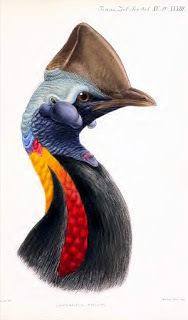 Plate XXXIII from Lord Walter Rothschild's definitive cassowary monograph, portraying the still-mysterious Sclater's cassowary Casuarius philipi (public domain)
Plate XXXIII from Lord Walter Rothschild's definitive cassowary monograph, portraying the still-mysterious Sclater's cassowary Casuarius philipi (public domain)Distributed widely through Australasia, the cassowaries constitute a trio of imposing, forest-dwelling ratite species with black, spine-like feathers enlivened by brilliantly-coloured patches of red, mauve, or blue skin on their neck; a multifarious assemblage of commensurately gaudy neck wattles; and a horny helmet-like casque, again of varying appearance, on top of their head. The native tribes sharing their jungle domain often keep young cassowaries as pets, but greatly fear the adult birds on account of their formidable claws - with which, the natives aver, they can readily disembowel with a single kick anyone foolish enough to threaten them.
Even so, this does not prevent many tribes from utilising cassowaries as a form of feathered currency, trading living specimens or select portions of dead ones (particularly the casque, claws, and feathers) far and wide in exchange for useful items such as domestic livestock - and wives! The late Dr Thomas Gilliard, an expert on New Guinea avifauna, learnt that in Papua the rate of exchange for one live cassowary was eight pigs, or one woman!
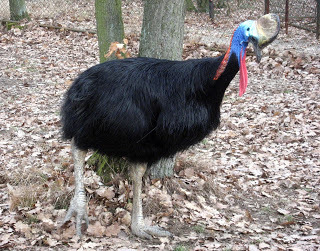 Photograph of an adult double-wattled cassowary in captivity (© Dezidor/Wikipedia)
Photograph of an adult double-wattled cassowary in captivity (© Dezidor/Wikipedia)During the early 17th Century, scholar Charles de l'Écluse placed on record the eventful history of the first cassowary ever seen in Europe - a much-travelled specimen originally captured on the Moluccan island of Seram (Ceram), but brought back to Amsterdam in 1597 from Java (after locals had taken it there some time earlier from Banda, another Moluccan island) by the first Dutch expedition to the East Indies. Given to the expedition by the ruler of the Javanese town of Sydayo(only a day or so before he then murdered the expedition's skipper!), it lost no time in becoming a much-coveted cassowary following its arrival in Holland.
Effortlessly ascending ever higher through the rarefied strata of European high society, after a period of several months as the star of a highly successful public exhibition at Amsterdam this distinguished bird passed into the hands of Count George Everard Solms and journeyed to the Hague, and later it was owned for a time by the Elector Palatine, Prince Ernestus of Cologne, before attaining the zenith of its fame by becoming the property of no less a personage than Emperor Rudolph II of the Holy Roman Empire.
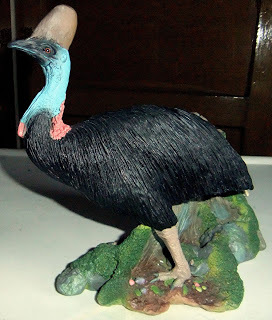 Beautiful 7.5-in-tall resin model (manufacturer unknown to me) of the double-wattled (southern) cassowary Casuarius casuarius, bought for me by my mother Mary Shuker in 2012 (photo © Dr Karl Shuker)
Beautiful 7.5-in-tall resin model (manufacturer unknown to me) of the double-wattled (southern) cassowary Casuarius casuarius, bought for me by my mother Mary Shuker in 2012 (photo © Dr Karl Shuker)Its species became known as Casuarius casuarius, the Seramor common cassowary, which is the tallest of the three modern-day species of cassowary, averaging 5.5 ft in height (including its lofty casque). It generally bears two wattles on its neck, so today it is most frequently called the double-wattled cassowary (a name originally given to C. bicarunculatus, but which is now known to be conspecific with C. casuarius anyway – see later in this article). Moreover, due to its most southerly distribution among cassowaries, occurring not only in New Guinea and various much smaller northerly islands close by but also as far south as Australia, C. casuarius is additionally referred to as the southern cassowary.
 Casuarius casuarius
illustration from 1861 (public domain)
Casuarius casuarius
illustration from 1861 (public domain)Based in most cases upon only the most trivial of differences in the colour, number, and shape of their wattles and also upon the shape of their casque (all characteristics now known to be exceedingly variable and of little if any taxonomic significance), a highly confusing plethora of species and subspecies all supposedly distinct from Seram's C. casuarius were described during the 19th Century, particularly by Lord Walter Rothschild, who documented a bewildering array of them in his comprehensive study 'A monograph of the genus Casuarius', published in December 1900 as an extensive, fully-illustrated paper within the Transactions of the Zoological Society of London.
(Indeed, Rothschild held such a passion for these striking birds that for research purposes he had no less than 62 mounted specimens prepared and housed at his once-private natural history museum at Tring, in Hertfordshire, which is now the ornithological section of London's Natural History Museum, where they remain today; and he also maintained a number of living specimens for study there.)
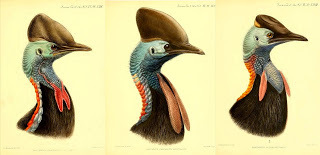 Seram cassowary Casuarius casuarius on left; Australian cassowary C. (c.) australis in centre; and Aru Islandsdouble-wattled cassowary C. bicarunculatus on right – painted by Keulemans, from Rothschild's monograph (public domain)
Seram cassowary Casuarius casuarius on left; Australian cassowary C. (c.) australis in centre; and Aru Islandsdouble-wattled cassowary C. bicarunculatus on right – painted by Keulemans, from Rothschild's monograph (public domain)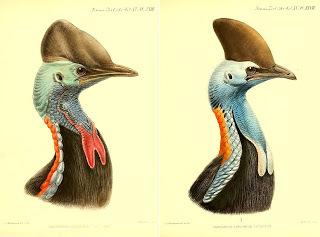 Beccari's cassowary C. (c.) beccarii on left and blue-necked cassowary C. (c.) intensus on right – painted by Keulemans, from Rothschild's monograph (public domain)
Beccari's cassowary C. (c.) beccarii on left and blue-necked cassowary C. (c.) intensus on right – painted by Keulemans, from Rothschild's monograph (public domain)These once-discrete species and subspecies included the Australian cassowary C. (c.) australis (from northeastern Australia, first recorded by Europeans in 1854); Beccari's cassowary C. (c.) beccarii, the violet-necked cassowary C. (c.) violicollis, and the Aru Islands double-wattled cassowary C. bicarunculatus (all three from the Aru Islands); Salvadori's cassowary C. (c.) tricarunculatus [aka salvadorii] (Geelvink Bay in Indonesian New Guinea or Irian Jaya); the blue-necked cassowary C. (c.) intensus (provenance unrecorded); and the single-wattled cassowary C. unappendiculatus (Salawati Island).
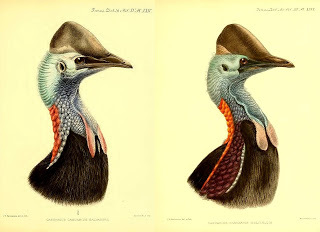 Salvadori's cassowary C. (c.) tricarunculatus on left and violet-necked cassowary C. (c.) violicollis on right – painted by Keulemans, from Rothschild's monograph (public domain)
Salvadori's cassowary C. (c.) tricarunculatus on left and violet-necked cassowary C. (c.) violicollis on right – painted by Keulemans, from Rothschild's monograph (public domain)Only the last-mentioned form, however, is still recognised as a genuinely separate species (indeed, today most ornithologists do not even split C. casuarius into any subspecies, let alone species). Standing 4.5-5.5 ft tall and known both as the single-wattled cassowary and as the northern cassowary, C. unappendiculatus also inhabits mainland New Guineaand the offshore islands of Misol and Japen.
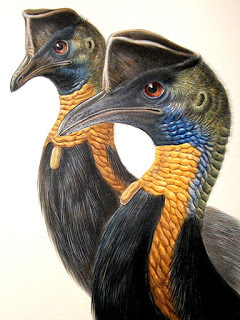 Single-wattled cassowaries, painted by John Gould during the 19th Century (public domain)
Single-wattled cassowaries, painted by John Gould during the 19th Century (public domain) It was first made known to science by Edward Blyth in January 1860, by way of a living specimen of unrecorded provenance but which had been brought to Calcutta, India, and was observed by him there in an aviary owned by the Bábu Rajendra Mullick.
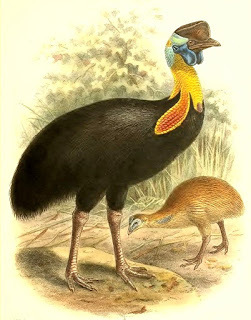 Single-wattled cassowary and brown-plumed juvenile, painted by Keulemans, from Rothschild's monograph (public domain)
Single-wattled cassowary and brown-plumed juvenile, painted by Keulemans, from Rothschild's monograph (public domain)Three years earlier, Dr George Bennett, a surgeon and biologist from New South Wales, Australia, had recorded the existence on the large island of New Britain (just off eastern New Guinea) of a cassowary whose unusually small size, lack of wattles, and noticeably flattened casque left no room for doubt that, unlike so many other forms being described and named at around that time, this really was a radically new, well-delineated species. Known to the natives as the mooruk and only up to 3.5 fttall, it was christened C. bennetti, Bennett's cassowary aka the dwarf cassowary, by John Gould, with Bennett sending a specimen to London.
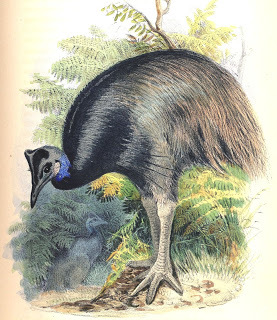 An inquisitive-looking mooruk and chick portrayed in an illustration from 1860 (public domain)
An inquisitive-looking mooruk and chick portrayed in an illustration from 1860 (public domain)Greatly intrigued by this diminutive species, Bennett obtained two mooruks from New Britain and gave them the freedom of his home in Sydney – discovering that they made entertaining if inquisitive house-guests, as summarised in W. H. Davenport Adams's book The Bird World (1885):
"The birds…were very tame; they ran freely about his house and garden - fearlessly approaching any person who was in the habit of feeding them. After a while they grew so bold as to disturb the servants while at work; they entered the open doors, followed the inmates step by step, pried and peered into every corner of the kitchen, leaped upon the chairs and tables, flocked round the busy and bountiful cook. If an attempt were made to catch them, they immediately took to flight, hid under or among the furniture, and lustily defended themselves with beak and claw. But as soon as they were left alone they returned, of their own accord, to their accustomed place. If a servant-maid endeavoured to drive them away, they struck her and rent her garments. They would penetrate into the stables among the horses, and eat with them, quite sociably, out of the rack. Frequently they pushed open the door of Bennett's study, walked all around it gravely and quietly, examined every article, and returned as noiselessly as they came."
The discovery of Bennett's cassowary was followed by the documentation of other, similarly undersized, wattle-less types, initially treated as distinct species, especially once again by Rothschild. These included Westermann's cassowary C. papuanus (Arfak Peninsulain northwestern Indonesian New Guinea), Loria's cassowary C. loriae(southern Papua New Guinea), and the painted cassowary C. picticollis (southeastern Papua New Guinea), but all of them are classified today as being conspecific with C. bennetti.
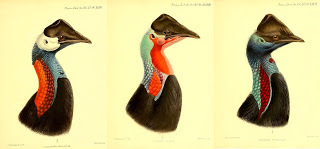 Westermann's cassowary C. papuensis on left; Loria's cassowary C. loriae in centre; and painted cassowary C. picticollis on right – painted by Keulemans, from Rothschild's monograph (public domain)
Westermann's cassowary C. papuensis on left; Loria's cassowary C. loriae in centre; and painted cassowary C. picticollis on right – painted by Keulemans, from Rothschild's monograph (public domain)And so, whittled down from a considerable number formerly deemed to be taxonomically distinct species of cassowary, only three are recognised nowadays (with no subspecies among any of them). A fourth valid species, the pygmy cassowary C. lydekkeri, which was very closely related to Bennett's cassowary yet even smaller in size, existed in the Southern Highlands of Papua New Guinea and also in Australia during the Late Pleistocene epoch, occurring as far south as the Wellington Valley of New South Wales, but it is now extinct.
In addition, however, there is one truly enigmatic form that remains mystifying and unique even today – Sclater's cassowary.
Formally described and christened Casuarius philipi in 1898 by Rothschild in his own scientific journal Novitates Zoologiae and fully documented in his monograph two years later, Sclater's cassowary was named in honour of the eminent British zoologist Dr Philip L. Sclater. Over a century later, however, it is still known only from its type specimen, which was living at London Zoo when Rothschild's monograph was written, having been shipped there from Calcutta, but whose native provenance is unknown (though Rothschild speculated that it may have come from eastern German New Guinea, now Papua New Guinea's northeastern portion). Moreover, the only image of it known to me is the 'head-and-shoulders' full-colour painting of it produced by the renowned Dutch bird illustrator John Gerrard Keulemans, who prepared it from the living bird, and which appears as Plate XXXIII in Rothschild's monograph. Here it is:
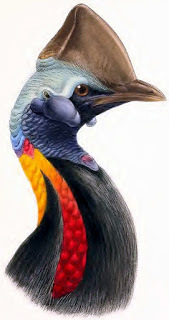 Keulemans's painting (close-up view) of Sclater's cassowary, from Rothschild's monograph (public domain)
Keulemans's painting (close-up view) of Sclater's cassowary, from Rothschild's monograph (public domain)Although he allied it most closely to the single-wattled (northern) cassowary (and is deemed conspecific with that latter species by current ornithological consensus), judging from Rothschild's verbal account of its complete form, however, this individual bird must have been truly extraordinary in overall appearance. Here is Rothschild's full description of it in his monograph:
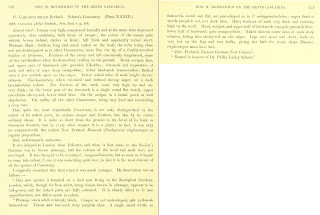 Rothschild's description of Sclater's cassowary on pp. 138-139 of his monograph – click to enlarge for reading purposes (public domain)
Rothschild's description of Sclater's cassowary on pp. 138-139 of his monograph – click to enlarge for reading purposes (public domain)As can be seen, Rothschild revealed that although in height Sclater's cassowary was no taller than Bennett's dwarf moa C. bennetti due to its very stout but short legs, in overall proportions it was exceptionally robust – so much so, in fact, that he went so far as to liken its form to that of the bulkiest, sturdiest species of New Zealand moa, the aptly-named heavy-footed moa Pachyornis elephantopus (elephantopusactually translates as 'elephant-footed'). Moreover, its very bulky body was set very low on its legs, drawing further comparisons with the latter moa.
Bearing in mind that Sclater's cassowary is known entirely from just one specimen, however, it would not be outlandish to explain its remarkable form merely as extreme individual variation upon the normal single-wattled cassowary theme – but its body stature and poise were not the only anomalous features exhibited by this extraordinary bird.
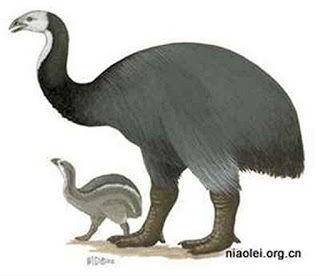 Reconstruction of the heavy-footed moa Pachyornis elephantopus from
here
(© niaolei.org.cn)
Reconstruction of the heavy-footed moa Pachyornis elephantopus from
here
(© niaolei.org.cn)Equally bizarre were its feathers, which were not disintegrated in structure like those of all other cassowaries, and were abnormally long on its rump, to the extent that some of those latter feathers actually touched the ground. Moreover, by being not only compressed laterally but also depressed posteriorly, its casque seemed to be a unique composite of the two different casque forms individually recorded from all other cassowaries. Even its cry – described by Rothschild as very loud and resembling a deep roar – instantly distinguished this most contentious of cassowaries from all others.
So what exactly was Sclater's cassowary – simply a one-off freak specimen of the single-wattled cassowary, or might it possibly be the only scientifically recorded specimen of a taxonomically distinct subspecies or even species in its own right? Over a century later, we still have no answer to this tantalising question, but as its holotype is retained at Tring Natural History Museum, we must hope that one day some genetic analyses will be conducted upon it to reveal its true identity at last.
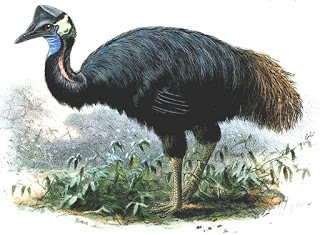 Bennett's cassowary or mooruk, painted by Keulemans in 1872 (public domain)
Bennett's cassowary or mooruk, painted by Keulemans in 1872 (public domain)Among the wealth of myth and folklore associated with cassowaries is a most curious conviction fostered by such tribes as the Huri and the Wola from Papua New Guinea's remote Southern Highlands Province. According to their lore, a female Bennett's cassowary maintained in captivity is able to reproduce even if she is not provided with a male partner. All that she has to do is locate a specific type of tree and thrust her breast against its trunk, again and again, in an ever-intensifying frenzy, until at last she collapses onto the floor in a state of complete exhaustion, suffering from internal bleeding that festers and clots to yield yellow pus. This in turn proliferates, producing yolk-containing eggs that the female lays, and which are incubated and hatch as normal.
Although a highly bizarre tale, it is worth recalling that cases of parthenogenesis (virgin birth) are fully confirmed from a few species of bird, notably the common turkey, in which the offspring are genetically identical to their mother. Perhaps, therefore, this odd snippet of native folklore should be investigated - just in case (once such evident elements of fantasy as the pus-engendered yolk are stripped away) there is a foundation in fact for it, still awaiting scientific disclosure.
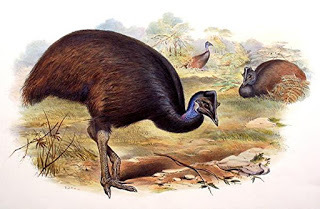 Bennett's cassowaries, painted by John Gould during the 19th Century (public domain)
Bennett's cassowaries, painted by John Gould during the 19th Century (public domain) An even more imaginative Wola belief regarding Bennett's cassowary concerns its migratory habits. As revealed by Paul Sillitoe during a filming expedition to Wola territory in 1978 (Geographical Journal, May 1981), these birds only visit this area when the fruits upon which they feed are in season here. At the season's end they travel further afield again, but the Wola are convinced that they have gone to live in the sky with a thunder goddess (though they neglect to reveal how these flightless birds become airborne!).
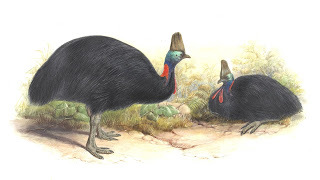 A pair of double-wattled cassowaries, painted by Henry Constantine Richter in 1851 (public domain)
A pair of double-wattled cassowaries, painted by Henry Constantine Richter in 1851 (public domain)Irrespective of these charming tales, it is true that for flightless birds the cassowaries do exhibit an extraordinarily dispersed, far-flung distribution - occurring on a surprising number of different islands. Admittedly, many of these islands were once joined to one another in the not-too-distant geological past, but some ornithologists remain doubtful that the cassowaries' range is entirely natural - suggesting instead that they may have been introduced onto certain of their insular territories via human agency.
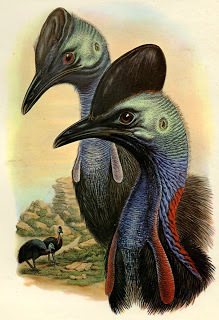 Double-wattled cassowaries, painted by John Gould, from his book The Birds of New Guinea and the Adjacent Papuan Islands (1888) (public domain)
Double-wattled cassowaries, painted by John Gould, from his book The Birds of New Guinea and the Adjacent Papuan Islands (1888) (public domain)For example, Drs A.L. Rand and Thomas Gilliard proposed in their Handbook of New Guinea Birds (1967) thatC. casuarius may well have been brought by humans to Seram. In view of the New Guinea tribes' very extensive trade in cassowaries - not only transporting them across land but also exporting them far and wide in boats (a tradition known to have been occurring for at least 500 years) - such a possibility is by no means implausible. It was raised in 1975 by Dr C.M.N. White too, within the British Ornithologists Club's bulletin, and he offered a corresponding explanation in the same publication the following year for the presence on New Britain of Bennett's cassowary.
Incidentally, another intriguing zoogeographical anomaly featuring Bennett's cassowary is its unexpected portrayal upon a postage stamp issued on 1 July 1909 by North Borneo (now the Borneo-sited Malaysian state of Sabah), bearing in mind that this species does not occur anywhere on Borneo. In fact, as revealed in The Stamps and Postal History of North Borneo, Part III: 1909-1938 by L.H. Shipman and P.K. Cassels, the explanation for this philatelic puzzle is that the intended bird for this particular stamp was not Bennett's cassowary at all, but rather a megapode (specifically the Philippine megapode Megapodius cumingii, which is indeed native here – not the dusky megapode M. freycinet, incidentally, as erroneously claimed in certain sources, which is notnative here). But somehow the wrong bird was chosen for the design, and the stamp was duly prepared and issued before the mistake was discovered. In wry recognition of the error, however, this stamp has been referred to ever since in North Borneo as the megapode stamp.
 The infamous cassowary postage stamp issued in 1909 by North Borneo (public domain)
The infamous cassowary postage stamp issued in 1909 by North Borneo (public domain)Probably the most unexpected variation on the theme of displaced cassowaries, however, is a case aired by Drs G.H. Ralph von Koenigswald and Joachim Steinbacher in a Natur und Museum paper published in 1986. They reported the presence of a bas-relief glyph depicting a readily-identifiable cassowary at Tjandi-Panataran – a Hindu temple not far from Wadjak in eastern Java, and dating from around the 12th-15thCentury AD. As there is no evidence to imply that Java ever harboured a native form of cassowary, this depiction lends itself to a variety of different cultural interpretations.
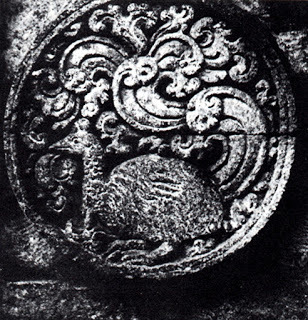 The cassowary glyph present at eastern Java's Tjandi-Panataran temple (public domain)
The cassowary glyph present at eastern Java's Tjandi-Panataran temple (public domain)For instance, it suggests that the centuries-old tradition of cassowary trade and export from New Guinea may have even extended as far afield as Java, or at least that the cassowary had been taken to Java from some other nearby island that may have originally received it from New Guinea (e.g. Banda, Seram). Alternatively, the depiction might simply have been based upon descriptionsof cassowaries, recounted to the Javan natives by visiting New Guinea traders. There is even the chance that the Javan tribe responsible for this glyph was descended from one that had migrated to southeast Asia from New Guinea, and the glyph's image was inspired by orally-preserved traditions among this translocated people of birds known to their ancestors in New Guinea.
When dealing with birds as unforgettable as the incomparably compelling and effortlessly memorable cassowaries, (almost) anything seems possible!
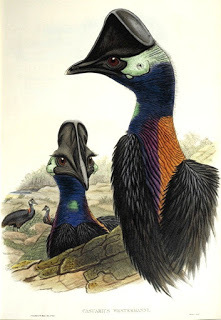 Westermann's cassowaries, painted by John Gould during the 19th Century (public domain)
Westermann's cassowaries, painted by John Gould during the 19th Century (public domain)This ShukerNature blog article is excerpted and greatly expanded from my book The Beasts That Hide From Man .
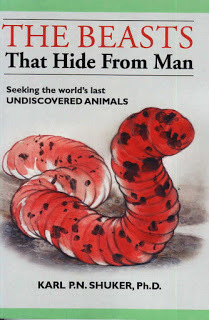
Published on June 27, 2015 17:39
June 6, 2015
WAS A GOLDEN FRESHWATER OARFISH ENCOUNTERED DURING THE VIETNAM WAR?
 Illustration of a normal silver-scaled giant oarfish modified by me into a golden-scaled giant oarfish matching Craig Thompson's description (© Dr Karl Shuker/original unmodified illustration © Field Book of Giant Fishes, GP Putnam)
Illustration of a normal silver-scaled giant oarfish modified by me into a golden-scaled giant oarfish matching Craig Thompson's description (© Dr Karl Shuker/original unmodified illustration © Field Book of Giant Fishes, GP Putnam)As I extensively documented in a previous ShukerNature blog article (click here ), down through the years the giant oarfish Regalecus glesne has been variously proposed and deposed by conflicting cryptozoological opinion as a plausible identity for various serpentiform marine cryptids. Now, however, I present what has been claimed to be a giant oarfish – but one of exceedingly unusual appearance and activity, let alone location – as the identity of a Far Eastern serpentiform freshwater cryptid unexpectedly encountered during the Vietnam War.
In his book Very Crazy, G.I.: Strange But True Stories of the Vietnam War (2001), Vietnam combat veteran Kregg P.J. Jorgenson reported that in 1999 he learnt of a truly extraordinary encounter, allegedly made by Craig Thompson, who had served in Vietnam as a 20-year-old sergeant E-5 from Coeur d'Alene, Idaho, with Company B, 2d Battalion of the 503d Parachute Infantry Regiment, 173d Airborne Brigade. Thompson claimed that his platoon had been bathing one day in the Bong Son River, in Vietnam's Binh Dinh Province, when one of the soldiers caught sight of a large serpent-like creature swimming up the river towards them.
They estimated it to be at least 30 ft long, and 1-2-ft wide, covered in glistening gold scales. Of particular note was that its large square head bore a dark red plume that stood high out of the water as it swam, and its long undulating body trailed behind. Not surprisingly, Thompson and his men shouted to each another to get out of the water as they reached for their weapons; but before they had time to do so, the creature disappeared beneath the murky waters and was seen no more.
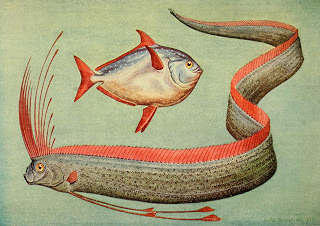 The Field Book of Giant Fishes' original unmodified illustration of a giant oarfish (plus an opah), revealing its typically silver-coloured scales (© Field Book of Giant Fishes, GP Putnam)
The Field Book of Giant Fishes' original unmodified illustration of a giant oarfish (plus an opah), revealing its typically silver-coloured scales (© Field Book of Giant Fishes, GP Putnam)For a long time, Thompson remained perplexed as to the zoological identity of this 'golden dragon', until he learnt about the giant oarfish, which is what he now believes that he and his platoon saw – and certainly, this red-crested serpentiform species does indeed come to mind when reading his report.
Nevertheless, there are some notable discrepancies too, because giant oarfishes are normally silver in colour, not gold; they are marine and normally mesopelagic, not freshwater and surface-dwelling; and even in those very rare instances when they are seen swimming near the surface (click here to view a video of one such instance), they do not do so with their crest erect, standing high out of the water. So if Thompson's report is genuine, how can these anomalies be explained?
 Kregg P.J. Jorgenson's fascinating book, which also contains details regarding his own sighting of a bipedal Vietnamese crypto-primate known locally as a rock ape (© Kregg P.J. Jorgenson/Ballantine Books)
Kregg P.J. Jorgenson's fascinating book, which also contains details regarding his own sighting of a bipedal Vietnamese crypto-primate known locally as a rock ape (© Kregg P.J. Jorgenson/Ballantine Books)In his book, Jorgenson claimed that gold and brown versions of the giant oarfish have been found in Australia and also off Mexico, but I have not seen pictures of any such specimens. True, reflecting sunlight and/or river silt clinging to its scales may conceivably have rendered the creature golden in appearance, but in view of how closely and clearly it was seen (and by so many eyewitnesses, not just one), both options seem rather unlikely. Equally, I am not aware of any records of the giant oarfish turning up in rivers, nor indeed of it swimming anywhere at all with its red crest raised up above the water surface. Certain moray eels in the Far East do venture into freshwater, and have golden-brown scales, but they are far smaller than the dimensions offered for the Vietnam creature, and, crucially, they do not possess the latter's high red crest, which is a diagnostic characteristic of the giant oarfish. At present, therefore, Thompson's freshwater 'golden dragon' oarfish remains an unresolved enigma.
Yet if such a creature (or cryptid, as it assuredly must be) really does exist, and regardless of whether or not it actually is a giant oarfish, it may help to explain at least some of the ancient Far Eastern legends of golden freshwater dragons, and also of crested nagas with gilded scales - as regally portrayed, for instance, by various imposing statues at Bangkok's Royal Palaces in Thailand.
 Gilded statue of a multi-headed naga in the Royal Palaces complex in Bangkok, Thailand (© Dr Karl Shuker)
Gilded statue of a multi-headed naga in the Royal Palaces complex in Bangkok, Thailand (© Dr Karl Shuker)If anyone reading this ShukerNature article has come upon information regarding golden oarfishes, whether of freshwater or of marine occurrence, I'd welcome any details that you could post here – thanks very much!
Also, my thanks to Matt Bille for bringing to my attention Jorgenson's book containing Thompson's very intriguing report.
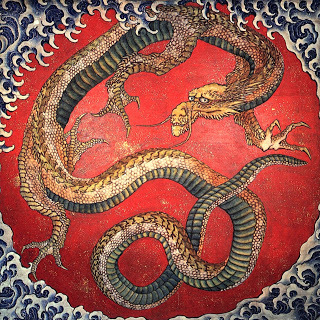 A typically elongate-bodied, golden-scaled Oriental dragon, by Katsushika Hokusai (public domain)
A typically elongate-bodied, golden-scaled Oriental dragon, by Katsushika Hokusai (public domain)
Published on June 06, 2015 19:47
June 5, 2015
MARSUPIAL SABRE-TOOTHS, QUEENSLAND TIGERS, BLUE MOUNTAINS LIONS, AND A MOST ELUSIVE CRYPTO-CUTTING
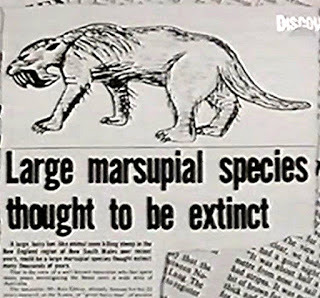 Screen-shot of the elusive and highly bemusing Australian newspaper cutting containing a Thylacosmilus-like sketch (source and copyright owner unknown to me)
Screen-shot of the elusive and highly bemusing Australian newspaper cutting containing a Thylacosmilus-like sketch (source and copyright owner unknown to me)A great many cryptozoological mysteries have crossed my path down through the years, and I've managed to provide answers to quite a number of them, but some still perplex me to this day – and this is one of them.
In 1980, a very popular television series screened in the UK was Arthur C. Clarke's Mysterious World, produced by Yorkshire TV, in which the renowned, eponymous science-fiction writer presented a wide range of unexplained phenomena. Four episodes in this series were devoted to cryptozoological subjects. One of these dealt with sea monsters, one with lake monsters, one with man-beasts, and one (entitled 'Dragons, Dinosaurs and Giant Snakes' and viewable online here ) with a wide assortment of other mystery creatures – including giant snakes, the king cheetah, the New Guinea dragon, the mokele-mbembe, and the thylacine or Tasmanian wolf Thylacinus cycnocephalus.
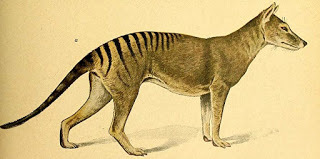 Vintage illustration from 1919 of the very canine thylacine (public domain)
Vintage illustration from 1919 of the very canine thylacine (public domain)The very short thylacine section included the briefest of shots (viewable at 6.43 to 6.44 in the online version linked to above) revealing an assortment of newspaper cuttings, one of which caught my eye due to the extremely intriguing sketch that it contained – bearing a remarkable resemblance to the long-extinct South American 'marsupial sabre-tooth' known as Thylacosmilus. Yet because this cutting was shown immediately before a clip of film depicting the last living thylacine (with all of the other cuttings in that shot dealing specifically with the thylacine), the creature that the sketch represented had evidently been reported from Australia, not South America. Indeed, during that same brief shot the narrator actually stated: "Who would believe the current stories of a sabre-toothed killer loose even now in the Australian bush…?" before moving on to introduce the thylacine clip.
Consequently, I could only assume that the cutting concerned the Queensland tiger (aka the yarri), because this is the only notable big-toothed feline cryptid reported Down Under (Australia's so-called mystery pumas and black panthers appear little if any different from their official namesakes), and that the sketch was therefore meant to represent (accurately or otherwise) an eyewitness description of one such animal.
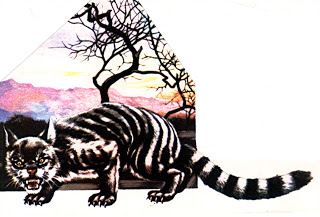 Artistic impression of the very feline yarri or Queensland tiger, but given enlarged canines, not enlarged thylacoleonid incisors (© Dami Editore s.r.l.)
Artistic impression of the very feline yarri or Queensland tiger, but given enlarged canines, not enlarged thylacoleonid incisors (© Dami Editore s.r.l.)I have long been fascinated by this particular cryptid and have amassed a very sizeable file of sighting reports (many of which have been documented by me in various of my books, particularly Mystery Cats of the World , In Search of Prehistoric Survivors , and Cats of Magic, Mythology, and Mystery ), but I am only aware of a single yarri eyewitness who has ever compared what they saw to a sabre-tooth, and even then, as the eyewitness specified, the comparison merely concerned the shape of its teeth, not their size.
 Australian cryptozoologist/author Rebecca Lang's spectacular Thylacoleo carnifex figurine, created by Sean Cooper, and constructed/painted by Jeff Johnson (© Rebecca Lang/Sean Cooper/Jeff Johnson)
Australian cryptozoologist/author Rebecca Lang's spectacular Thylacoleo carnifex figurine, created by Sean Cooper, and constructed/painted by Jeff Johnson (© Rebecca Lang/Sean Cooper/Jeff Johnson) Equally, the most popular identity for the yarri that has been proffered by cryptozoologists is a living thylacoleonid – characterised in its most famous, biggest, and most recently-surviving species, the marsupial or pouched lion Thylacoleo carnifex, by greatly-enlarged, tusk-like incisors (whereas in true, placental sabre-tooths it was the upper canines that were greatly enlarged).
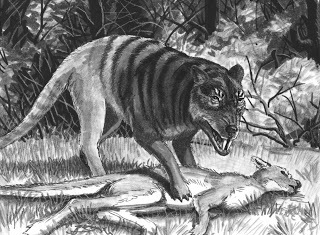 Reconstruction of the yarri with thylacoleonid enlarged incisors (© William Rebsamen)
Reconstruction of the yarri with thylacoleonid enlarged incisors (© William Rebsamen)Moreover, even true, placental sabre-tooths did not possess the extremely pronounced, paired, scabbard-like lower-jaw flanges sported by the creature portrayed in the cutting's sketch. Only South America's marsupial sabre-tooth Thylacosmilus exhibited these very distinctive attributes, composed of bone, which served to sheath and protect its huge curved upper canines.
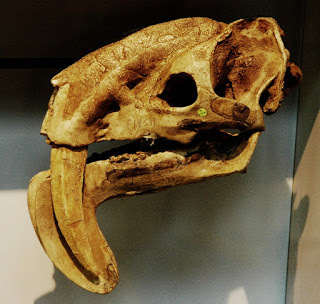 Thylacosmilus
skull at London's Natural History Museum (© Alexei Kouprianov/Wikipedia)
Thylacosmilus
skull at London's Natural History Museum (© Alexei Kouprianov/Wikipedia)Formally described and named in 1933, known to exist in Argentina from the early Miocene to the late Pliocene epoch, and believed to have been as large as a modern-day leopard or jaguar, the single but highly impressive species Thylacosmilus atrox is popularly referred to as the marsupial or pouched sabre-tooth (the translation of its generic name), due to its deceptively similar outward appearance to the true, placental (eutherian) sabre-tooths or machairodontids but much closer taxonomic affinity to the marsupials as a fellow metatherian. Indeed, it was long classed, along with the morphologically more canine South American borhyaenids, within the same taxonomic order, Marsupialia, as the New World's opossums and caenolestids (rat opossums) and all of Australia's marsupials too. Nowadays, however, Marsupialia is split up into several separate orders, and Thylacosmilus plus the borhyaenids are now housed within the wholly-extinct taxonomic order Sparassodonta.
 Restoration of Thylacosmilus atroxin life (with glyptodont in background) – interestingly, it has been portrayed here with very thylacine-like stripes (public domain)
Restoration of Thylacosmilus atroxin life (with glyptodont in background) – interestingly, it has been portrayed here with very thylacine-like stripes (public domain)Contrary to former belief, Thylacosmilusbecame extinct at least one million years before South America was invaded by the eutherian sabre-tooth genus Smilodon(during the mid-Pleistocene), following the latter continent's connection to North America via the appearance of the interconnecting isthmus of Panama. Consequently, the two forms never encountered one another, thereby dismissing prior claims that, as has often happened in instances when metatherian and eutherian counterparts have been brought together, Thylacosmilus was out-competed and thus annihilated by Smilodon.
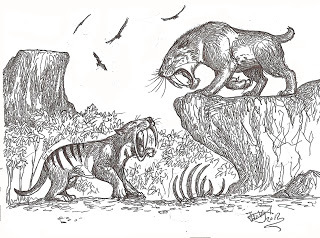 What if…? – Thylacosmilus vs Smilodon, an imaginary confrontational scenario, as these two mighty feline forms never met in reality (© Hodari Nundu)
What if…? – Thylacosmilus vs Smilodon, an imaginary confrontational scenario, as these two mighty feline forms never met in reality (© Hodari Nundu)All very interesting, undoubtedly, but unfortunately it doesn't shed any light upon the mystery of why this highly-specialised and exclusively South American feline carnivore had inspired a sketch ostensibly depicting a Queensland tiger in an Australian newspaper cutting.
Shortly after the Arthur C. Clarke-presented TV series was screened in Britain, I wrote to its producers Simon Welfare and John Fairley requesting a copy of this particular cutting (it had not been included in the bestselling book of the series), but I learnt from them that they hadn't retained any of the cuttings in that shot, and had no idea what had happened to them. The series' principal researcher, Adam Hart-Davis (now famous as an author, TV presenter, and producer in his own right), very kindly sent me for my own personal research use a videocassette containing all four of its cryptozoological episodes, and by pausing the video at the exact shot showing the cuttings I could just about read the cutting's heading (though as was often the case when freeze-framing video tapes, the picture shook quite considerably).
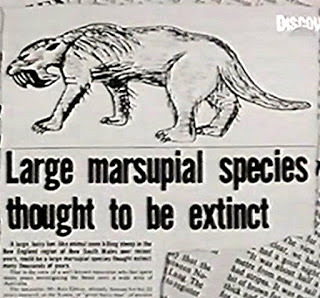 It's that missing cutting again! (Copyright owner and source unknown to me)
It's that missing cutting again! (Copyright owner and source unknown to me)With the advent of the internet, these episodes are now available to view online on YouTube, so I have been able to obtain a slightly better screen-shot of the cutting, as included at the beginning of this present ShukerNature blog article, but it is still not clear enough for much of its its text to be read, and the cutting was not included in its entirety within the shot anyway. However, I can pick out the words 'New South Wales' in the second line of main text beneath the heading, which makes things only more confusing still, because the yarri is apparently confined to Queensland, whereas NSW's feline cryptids are supposedly of the more prosaic puma and black panther varieties – but with one very notable yet little-known exception, documented by me as follows in my book In Search of Prehistoric Survivors (1995):
"Speaking of out-of-place felids, one or more African lions on the loose is the conservative explanation generally offered by naturalists when faced with the enigma of the Blue Mountains' maned mystery beasts. West of Sydney, New South Wales, the Blue Mountains have long been associated with rumours and reports of huge cat-like beasts of ferocious temperament. Interestingly, they are not confined to modern reports but were well known to the aboriginals who once inhabited this range. They called them warrigals ('rock dogs') - a name sometimes applied nowadays to the dingo, but it is clear from their descriptions that their warrigals were something very different from a dingo.
"Rex Gilroy has made a detailed study of the Blue Mountain lions, and according to his published account (Nexus, June-July 1992) the aboriginals described these animals as 6-7 ftlong, around 3 fthigh, with a large cat-like head, big shearing teeth that protruded from their jaws, brown fur (sometimes light, sometimes dark - sexual, or age, differences?), and a long shaggy mane. Testifying to these animals' continuing presence here, this is also an accurate portrait of the terrifying leonine beast that approached three young shooters in the Mulgoa district south of Penrith, close to the Blue Mountains' eastern escarpment, one day in 1977 - fleeing into nearby scrub only when the alarmed trio fired at it. A similar creature had been reported from this same region in 1972, where it had allegedly been killing sheep.
"Back in April 1945, a bushwalking party clambering down Mount Solitary's Korrowal Buttress made good use of their binoculars to watch four warrigals moving across Cedar Valley. And as recently as 1988, some campers near Hampton, west of Katoomba, saw one for themselves - this area had been experiencing some severe cases of cattle mutilation, a feature that crops up time and again when charting sightings of warrigals.
"Based upon the longstanding history of these animals, I find it difficult to believe that they could be escapee lions or suchlike. An undiscovered native species is the only tenable explanation - echoed by Gilroy, who proposes that the warrigal is a surviving species of pouched lion. As it differs markedly in appearance from the yarri, however, we can only assume that if Gilroy's hypothesis is correct there are two separate species of pouched lion currently prowling various portions of Australia's wildernesses - a remarkable concept, but nonetheless the only one that offers a satisfactory conclusion to this extraordinary saga."
So could the elusive cutting be referring these very mysterious protruding-toothed warrigals and be suggesting that they may be marsupial sabre-tooths, or at least comparing them to such creatures? This could then explain the presence within it of the otherwise-anomalous Thylacosmilus-reminiscent sketch.
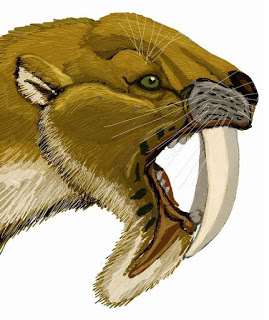 Portrayal of Thylacosmilus revealing its characteristic lower jaw flanges (public domain)
Portrayal of Thylacosmilus revealing its characteristic lower jaw flanges (public domain) Needless to say, I have spent quite some time seeking this very bemusing, tantalising cutting online, but as I have neither a source nor a publication date for it (other than the knowledge that it must have been published sometime prior to the TV series' original screening in 1980), it is not proving an easy task. Not even lengthy periods browsing through the archives of Trove, the invaluable website granting access to countless newspaper reports from Australian newspapers, has unfurled it so far (although during the process of searching for it on Trove, I did uncover a number of yarri articles previously unknown to me!).
And so, gentle reader, here is where you come in. If by any chance you have a copy of this highly elusive cutting, or any information concerning it, especially its date and/or source of publication, I would very greatly welcome any details that you could post here, and a scan of the cutting itself if you do happen to have the original to hand. Thanks very much!
UPDATE: 6 June 2015
Not long after posting this ShukerNature blog article online, I learnt independently from two of my longstanding Australian crypto-colleagues - Dr David Waldron and Paul Cropper - that the Thylacosmilus-like sketch featured in the mystery newspaper cutting had actually been prepared by none other than Australian cryptozoologist Rex Gilroy, who had brought to popular attention the previously-obscure Blue Mountains lions or warrigals. They also both revealed that this same sketch had featured in an article by Rex Gilroy on Australian cryptids that had originally appeared in the December 1976 issue of Psychic Australian, and which can be read online here . Here is the sketch as featured there, and which, as revealed in the article, is his impression of the possible morphology of the Blue Mountains lion based upon eyewitness accounts from the New England area of northern New South Wales:
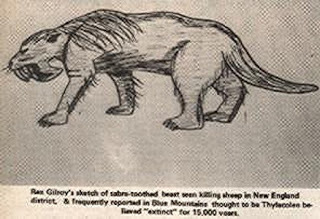 Rex Gilroy's sketch of the Blue Mountains lion or warrigal from his Psychic Australian article (© Rex Gilroy/Psychic Australian)
Rex Gilroy's sketch of the Blue Mountains lion or warrigal from his Psychic Australian article (© Rex Gilroy/Psychic Australian)Presumably, therefore, eyewitness claims that this cryptid possesses protruding teeth coupled with the fact that with the lone exception of the dingo, all of Australia's large confirmed mammalian species are marsupials, suggested to Rex that the Blue Mountains lion may resemble a marsupial sabre-tooth (and thence Thylacosmilus?), thereby influencing his resulting sketch of its putative appearance.
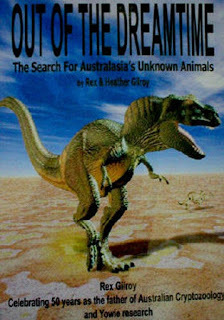 Out of the Dreamtime: The Search For Australasia's Unknown Animals (© Rex and Heather Gilroy/Uru Publications) His very extensive (43-chapter) self-published book Out of the Dreamtime: The Search For Australasia's Unknown Animals (2006?), co-authored with his wife Heather, contains an entire chapter on the Blue Mountain lions, but all attempts by me to locate a copy to purchase have so far failed (his website, click
here
, from which copies of all of his books could formerly be purchased, hasn't been updated for some years, and there does not seem to be any functioning facility on it now for book purchasing). So if anyone can suggest a source for his book, I'd greatly welcome details.
Out of the Dreamtime: The Search For Australasia's Unknown Animals (© Rex and Heather Gilroy/Uru Publications) His very extensive (43-chapter) self-published book Out of the Dreamtime: The Search For Australasia's Unknown Animals (2006?), co-authored with his wife Heather, contains an entire chapter on the Blue Mountain lions, but all attempts by me to locate a copy to purchase have so far failed (his website, click
here
, from which copies of all of his books could formerly be purchased, hasn't been updated for some years, and there does not seem to be any functioning facility on it now for book purchasing). So if anyone can suggest a source for his book, I'd greatly welcome details.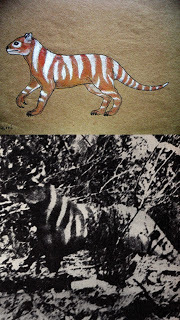 Reconstruction of the yarri (top), inspired by the controversial Ozenkadnook tiger photograph (bottom) snapped in 1964 by Rilla Martin near Goroke in Western Australia (© Markus Bühler/© Rilla Martin)
Reconstruction of the yarri (top), inspired by the controversial Ozenkadnook tiger photograph (bottom) snapped in 1964 by Rilla Martin near Goroke in Western Australia (© Markus Bühler/© Rilla Martin)
Published on June 05, 2015 19:02
MARSUPIAL SABRE-TOOTHS, QUEENSLAND TIGERS, BLUE MOUNTAIN LIONS, AND A MOST ELUSIVE CRYPTO-CUTTING
 Screen-shot of the elusive and highly bemusing Australian newspaper cutting containing a Thylacosmilus-like sketch (source and copyright owner unknown to me)
Screen-shot of the elusive and highly bemusing Australian newspaper cutting containing a Thylacosmilus-like sketch (source and copyright owner unknown to me)A great many cryptozoological mysteries have crossed my path down through the years, and I've managed to provide answers to quite a number of them, but some still perplex me to this day – and this is one of them.
In 1980, a very popular television series screened in the UK was Arthur C. Clarke's Mysterious World, produced by Yorkshire TV, in which the renowned, eponymous science-fiction writer presented a wide range of unexplained phenomena. Four episodes in this series were devoted to cryptozoological subjects. One of these dealt with sea monsters, one with lake monsters, one with man-beasts, and one (entitled 'Dragons, Dinosaurs and Giant Snakes' and viewable online here ) with a wide assortment of other mystery creatures – including giant snakes, the king cheetah, the New Guinea dragon, the mokele-mbembe, and the thylacine or Tasmanian wolf Thylacinus cycnocephalus.
 Vintage illustration from 1919 of the very canine thylacine (public domain)
Vintage illustration from 1919 of the very canine thylacine (public domain)The very short thylacine section included the briefest of shots (viewable at 6.43 to 6.44 in the online version linked to above) revealing an assortment of newspaper cuttings, one of which caught my eye due to the extremely intriguing sketch that it contained – bearing a remarkable resemblance to the long-extinct South American 'marsupial sabre-tooth' known as Thylacosmilus. Yet because this cutting was shown immediately before a clip of film depicting the last living thylacine (with all of the other cuttings in that shot dealing specifically with the thylacine), the creature that the sketch represented had evidently been reported from Australia, not South America. Indeed, during that same brief shot the narrator actually stated: "Who would believe the current stories of a sabre-toothed killer loose even now in the Australian bush…?" before moving on to introduce the thylacine clip.
Consequently, I could only assume that the cutting concerned the Queensland tiger (aka the yarri), because this is the only notable big-toothed feline cryptid reported Down Under (Australia's so-called mystery pumas and black panthers appear little if any different from their official namesakes), and that the sketch was therefore meant to represent (accurately or otherwise) an eyewitness description of one such animal.
 Artistic impression of the very feline yarri or Queensland tiger, but given enlarged canines, not enlarged thylacoleonid incisors (© Dami Editore s.r.l.)
Artistic impression of the very feline yarri or Queensland tiger, but given enlarged canines, not enlarged thylacoleonid incisors (© Dami Editore s.r.l.)I have long been fascinated by this particular cryptid and have amassed a very sizeable file of sighting reports (many of which have been documented by me in various of my books, particularly Mystery Cats of the World , In Search of Prehistoric Survivors , and Cats of Magic, Mythology, and Mystery ), but I am only aware of a single yarri eyewitness who has ever compared what they saw to a sabre-tooth, and even then, as the eyewitness specified, the comparison merely concerned the shape of its teeth, not their size.
 Australian cryptozoologist/author Rebecca Lang's spectacular Thylacoleo carnifex figurine, created by American artist and model maker Jeff Johnson (© Rebecca Lang/Jeff Johnson)
Australian cryptozoologist/author Rebecca Lang's spectacular Thylacoleo carnifex figurine, created by American artist and model maker Jeff Johnson (© Rebecca Lang/Jeff Johnson) Equally, the most popular identity for the yarri that has been proffered by cryptozoologists is a living thylacoleonid – characterised in its most famous, biggest, and most recently-surviving species, the marsupial or pouched lion Thylacoleo carnifex, by greatly-enlarged, tusk-like incisors (whereas in true, placental sabre-tooths it was the upper canines that were greatly enlarged).
 Reconstruction of the yarri with thylacoleonid enlarged incisors (© William Rebsamen)
Reconstruction of the yarri with thylacoleonid enlarged incisors (© William Rebsamen)Moreover, even true, placental sabre-tooths did not possess the extremely pronounced, paired, scabbard-like lower-jaw flanges sported by the creature portrayed in the cutting's sketch. Only South America's marsupial sabre-tooth Thylacosmilus exhibited these very distinctive attributes, composed of bone, which served to sheath and protect its huge curved upper canines.
 Thylacosmilus
skull at London's Natural History Museum (© Alexei Kouprianov/Wikipedia)
Thylacosmilus
skull at London's Natural History Museum (© Alexei Kouprianov/Wikipedia)Formally described and named in 1933, known to exist in Argentina from the early Miocene to the late Pliocene epoch, and believed to have been as large as a modern-day leopard or jaguar, the single but highly impressive species Thylacosmilus atrox is popularly referred to as the marsupial or pouched sabre-tooth (the translation of its generic name), due to its deceptively similar outward appearance to the true, placental (eutherian) sabre-tooths or machairodontids but much closer taxonomic affinity to the marsupials as a fellow metatherian. Indeed, it was long classed, along with the morphologically more canine South American borhyaenids, within the same taxonomic order, Marsupialia, as the New World's opossums and caenolestids (rat opossums) and all of Australia's marsupials too. Nowadays, however, Marsupialia is split up into several separate orders, and Thylacosmilus plus the borhyaenids are now housed within the wholly-extinct taxonomic order Sparassodonta.
 Restoration of Thylacosmilus atroxin life (with glyptodont in background) – interestingly, it has been portrayed here with very thylacine-like stripes (public domain)
Restoration of Thylacosmilus atroxin life (with glyptodont in background) – interestingly, it has been portrayed here with very thylacine-like stripes (public domain)Contrary to former belief, Thylacosmilusbecame extinct at least one million years before South America was invaded by the eutherian sabre-tooth genus Smilodon(during the mid-Pleistocene), following the latter continent's connection to North America via the appearance of the interconnecting isthmus of Panama. Consequently, the two forms never encountered one another, thereby dismissing prior claims that, as has often happened in instances when metatherian and eutherian counterparts have been brought together, Thylacosmilus was out-competed and thus annihilated by Smilodon.
 What if…? – Thylacosmilus vs Smilodon, an imaginary confrontational scenario, as these two mighty feline forms never met in reality (© Hodari Nundu)
What if…? – Thylacosmilus vs Smilodon, an imaginary confrontational scenario, as these two mighty feline forms never met in reality (© Hodari Nundu)All very interesting, undoubtedly, but unfortunately it doesn't shed any light upon the mystery of why this highly-specialised and exclusively South American feline carnivore had inspired a sketch ostensibly depicting a Queensland tiger in an Australian newspaper cutting.
Shortly after the Arthur C. Clarke-presented TV series was screened in Britain, I wrote to its producers Simon Welfare and John Fairley requesting a copy of this particular cutting (it had not been included in the bestselling book of the series), but I learnt from them that they hadn't retained any of the cuttings in that shot, and had no idea what had happened to them. The series' principal researcher, Adam Hart-Davis (now famous as an author, TV presenter, and producer in his own right), very kindly sent me for my own personal research use a videocassette containing all four of its cryptozoological episodes, and by pausing the video at the exact shot showing the cuttings I could just about read the cutting's heading (though as was often the case when freeze-framing video tapes, the picture shook quite considerably).
 It's that missing cutting again! (Copyright owner and source unknown to me)
It's that missing cutting again! (Copyright owner and source unknown to me)With the advent of the internet, these episodes are now available to view online on YouTube, so I have been able to obtain a slightly better screen-shot of the cutting, as included at the beginning of this present ShukerNature blog article, but it is still not clear enough for much of its its text to be read, and the cutting was not included in its entirety within the shot anyway. However, I can pick out the words 'New South Wales' in the second line of main text beneath the heading, which makes things only more confusing still, because the yarri is apparently confined to Queensland, whereas NSW's feline cryptids are supposedly of the more prosaic puma and black panther varieties – but with one very notable yet little-known exception, documented by me as follows in my book In Search of Prehistoric Survivors (1995):
"Speaking of out-of-place felids, one or more African lions on the loose is the conservative explanation generally offered by naturalists when faced with the enigma of the Blue Mountains' maned mystery beasts. West of Sydney, New South Wales, the Blue Mountains have long been associated with rumours and reports of huge cat-like beasts of ferocious temperament. Interestingly, they are not confined to modern reports but were well known to the aboriginals who once inhabited this range. They called them warrigals ('rock dogs') - a name sometimes applied nowadays to the dingo, but it is clear from their descriptions that their warrigals were something very different from a dingo.
"Rex Gilroy has made a detailed study of the Blue Mountain lions, and according to his published account (Nexus, June-July 1992) the aboriginals described these animals as 6-7 ftlong, around 3 fthigh, with a large cat-like head, big shearing teeth that protruded from their jaws, brown fur (sometimes light, sometimes dark - sexual, or age, differences?), and a long shaggy mane. Testifying to these animals' continuing presence here, this is also an accurate portrait of the terrifying leonine beast that approached three young shooters in the Mulgoa district south of Penrith, close to the Blue Mountains' eastern escarpment, one day in 1977 - fleeing into nearby scrub only when the alarmed trio fired at it. A similar creature had been reported from this same region in 1972, where it had allegedly been killing sheep.
"Back in April 1945, a bushwalking party clambering down Mount Solitary's Korrowal Buttress made good use of their binoculars to watch four warrigals moving across Cedar Valley. And as recently as 1988, some campers near Hampton, west of Katoomba, saw one for themselves - this area had been experiencing some severe cases of cattle mutilation, a feature that crops up time and again when charting sightings of warrigals.
"Based upon the longstanding history of these animals, I find it difficult to believe that they could be escapee lions or suchlike. An undiscovered native species is the only tenable explanation - echoed by Gilroy, who proposes that the warrigal is a surviving species of pouched lion. As it differs markedly in appearance from the yarri, however, we can only assume that if Gilroy's hypothesis is correct there are two separate species of pouched lion currently prowling various portions of Australia's wildernesses - a remarkable concept, but nonetheless the only one that offers a satisfactory conclusion to this extraordinary saga."
So could the elusive cutting be referring these very mysterious big-toothed warrigals and be suggesting that they may be marsupial sabre-tooths, or at least comparing them to such creatures? This could then explain the presence within it of the otherwise-anomalous Thylacosmilus-reminiscent sketch.
 Portrayal of Thylacosmilus revealing its characteristic lower jaw flanges (public domain)
Portrayal of Thylacosmilus revealing its characteristic lower jaw flanges (public domain) Needless to say, I have spent quite some time seeking this very bemusing, tantalising cutting online, but as I have neither a source nor a publication date for it (other than the knowledge that it must have been published sometime prior to the TV series' original screening in 1980), it is not proving an easy task. Not even lengthy periods browsing through the archives of Trove, the invaluable website granting access to countless newspaper reports from Australian newspapers, has unfurled it so far (although during the process of searching for it on Trove, I did uncover a number of yarri articles previously unknown to me!).
And so, gentle reader, here is where you come in. If by any chance you have a copy of this highly elusive cutting, or any information concerning it, especially its date and/or source of publication, I would very greatly welcome any details that you could post here, and a scan of the cutting itself if you do happen to have the original to hand. Thanks very much!
 Reconstruction of the yarri (top), inspired by the controversial Ozenkadnook tiger photograph (bottom) snapped in 1964 by Rilla Martin near Goroke in Western Australia (© Markus Bühler/© Rilla Martin)
Reconstruction of the yarri (top), inspired by the controversial Ozenkadnook tiger photograph (bottom) snapped in 1964 by Rilla Martin near Goroke in Western Australia (© Markus Bühler/© Rilla Martin)
Published on June 05, 2015 19:02
June 2, 2015
COMING TO A SWAMP NEAR YOU... LIZARD MEN, FROG MEN, AND REPTOIDS – OH MY!
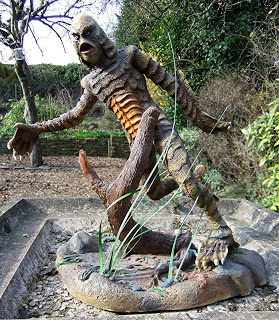 My official model of the 'Creature from the Black Lagoon' (© Dr Karl Shuker)
My official model of the 'Creature from the Black Lagoon' (© Dr Karl Shuker)The term ‘reptoid’ is most closely associated with the reptilian category of extraterrestrial aliens, but it also has a much wider yet less familiar usage, having been applied to a number of extraordinary humanoid reptilian entities reported from modern-day North America and elsewhere, as will be seen here.
LEAPING LIZARD MEN! ESCAPE FROM SCAPE ORE SWAMP
When a shaking, petrified 17-year old youth called Christopher Davis arrived home in a hysterical state with his car’s roof bearing several long deep scratches, his father was naturally shocked, but was even more so when his son, after finally calming down sufficiently to speak, told him a truly incredible tale of what he claimed had happened earlier that night.
According to Christopher, at 2 am on 29 June 1988, he had pulled up near to Scape Ore Swamp, just outside the South Carolina backwater village of Bishopville in Lee County, in order to change a tyre. But as he was replacing the jack in his car’s boot afterwards, he saw something very tall, approximately 7 ft in height, racing towards him at speed across a field. As it drew nearer, Christopher was amazed and horrified to discover that it resembled a huge bipedal lizard, with humanoid form but covered in green wet scaly skin, sporting just three fingers on each hand and three toes on each foot, every one tipped with a 4-in-long black claw, and glaring at him with slanted glowing red eyes!
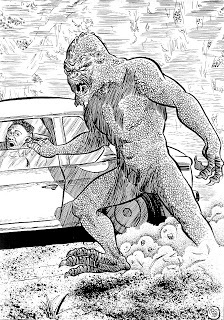 Artist's impression of Lizard Man (© Richard Svensson)
Artist's impression of Lizard Man (© Richard Svensson)Terrified, Christopher jumped into his car at once, but as he tried to slam the door shut, the creature – soon to be dubbed Lizard Man by the media – grabbed its mirror in an attempt to wrench the door open. Moreover, even though Christopher accelerated and drove off, his saurian attacker was not left behind. Instead, it hurled itself onto the car roof, and tried to hold on to it as the panic-stricken teenager drove madly through the swamplands, swerving wildly at speeds of up to 40 miles/hr in a desperate attempt to dislodge it from his roof. Happily for him, however, the creature quite literally outreached itself when it stretched its arm down to grab at the windscreen, because it lost its grip on the roof and fell off the car, to be left far behind as Christopher sped on to his home.
When the story broke, Lee County’s sheriff, Liston Truesdale, interviewed Christopher and also researched his background history, subsequently confirming that he accepted his story and had found him to be a very clean-living boy never linked to drugs or drinking. Moreover, in the weeks that followed, many other sightings of Lizard Man were reported in the same area, and by people again claimed by Truesdale to be of reputable status.
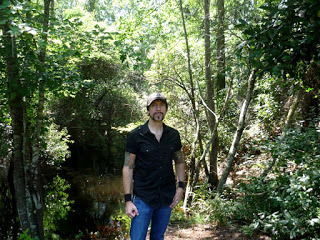 Lizard Man investigator Lyle Blackburn in Scape Ore Swamp (© Lyle Blackburn)
Lizard Man investigator Lyle Blackburn in Scape Ore Swamp (© Lyle Blackburn)Nevertheless, apart from some very large three-toed footprints of dubious origin turning up in the swamp and soon dismissed by police, no physical evidence for Lizard Man’s existence was forthcoming. Eventually, therefore, especially after certain more recent reports were exposed as definite hoaxes, Lizard Man faded from the headlines and into local folklore, but remains one of the most bizarre unidentified entities ever documented - a thoroughly surreal mystery that today is still resolutely unresolved. Or is it?
The most extensive modern-day investigation of the Bishopville Lizard Man is that of American cryptid researcher and author Lyle Blackburn. Lyle and his partner Cindy Lee not only visited the precise sighting locations, and interviewed those eyewitnesses still living, but also examined (and were even permitted to photograph) official eyewitness testimony records plus police documents of this extraordinary case, and thoroughly reviewed a comprehensive range of theories in their bid to provide a satisfactory explanation.
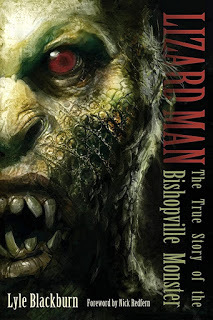 Lyle Blackburn's excellent book,
Lizard Man
(© Lyle Blackburn/Anomalist Books)
Lyle Blackburn's excellent book,
Lizard Man
(© Lyle Blackburn/Anomalist Books)But what did they discover, and what were their conclusions? The answers can be found in Lyle's fascinating book, Lizard Man: The True Story of the Bishopville Monster (2013), which I thoroughly recommend to everyone wishing to examine the full history of this truly bizarre being.
 Lyle Blackburn with his other cryptozoological bestseller, The Beast of Boggy Creek (© Lyle Blackburn)
Lyle Blackburn with his other cryptozoological bestseller, The Beast of Boggy Creek (© Lyle Blackburn) Incidentally, in an example not so much of art imitating nature as body art imitating unnatural history, one of today's most memorable (and certainly most eyecatching) of freak show performers is Eric Sprague.
Aka 'The Lizardman', he sports a full-body tattoo of green lizard-like scales, a modified bifurcate tongue, sharpened teeth, and subdermal implants, thereby converting his appearance to that of a veritable reptoid.
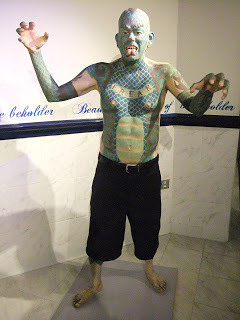 Life-sized replica of Eric Sprague, The Lizardman, currently on display at the Ripley's Believe It Or Not! Odditorium in London, England (© Dr Karl Shuker)
Life-sized replica of Eric Sprague, The Lizardman, currently on display at the Ripley's Believe It Or Not! Odditorium in London, England (© Dr Karl Shuker)THE REALCREATURES FROM THE BLACK LAGOON?
One of the most famous of all movie monsters is the scaly amphibious entity that appears in the cult American sci-fi/horror flick ‘Creature from the Black Lagoon’. Directed by Jack Arnold and produced by Universal Studios, it was originally released in 1954, and went on to spawn two sequels as well as all manner of derivative films in the years to come. Yet whereas its eponymous bipedal gill-man of Devonian descent and a penchant for abducting buxom brunettes was thankfully confined to the swamplands of the silver screen, there are a number of modern-day claims on file concerning real-life encounters with mysterious amphibious beings that bear much more than a passing (not to mention alarming) resemblance to it.
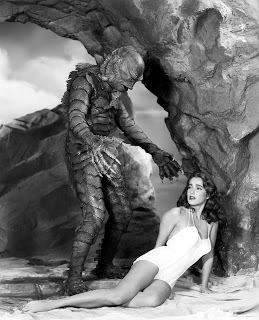 Still from 'Creature from the Black Lagoon' (© Universal Studios)
Still from 'Creature from the Black Lagoon' (© Universal Studios)Undoubtedly the most frightening of these took place on the evening of 8 November 1958, and featured Charles Wetzel, who was driving his Buick along the road bordering the Santa Ana River near Riverside, California, when someone – or something – suddenly leapt in front of his car and stood there, staring directly at him. Wetzel was astonished and terrified – for good reason. According to his subsequent testimony to the police and other investigators, the entity was bipedal and at least 7 ft tall, sported a round pumpkin-like head lacking a nose and ears but possessing a projecting beak-like mouth and a pair of bright fluorescent eyes, waved its extremely long arms so animatedly that its entire body rocked from side to side, stood on a pair of legs that splayed out from the sides of its torso like those of a reptile (rather than emerging from beneath its torso like a human’s do), and was covered in leaf-like scales.
And as if this stationary vision of horror was not enough, the reptoid then opened its beak, emitted a high-pitched gurgling scream, and raced directly towards Wetzel’s car, its long arms reaching across the bonnet and clawing madly at the windscreen as it violently strove to reach Wetzel! The petrified driver was armed with a rifle but did not dare shoot at the reptoid with it as the bullets would have destroyed the windscreen – the only barrier separating him from his frenzied saurian aggressor. Instead, he swiftly accelerated his car and ran the reptoid down, feeling its substantial body scraping the undercarriage as he drove over it and away with all speed.
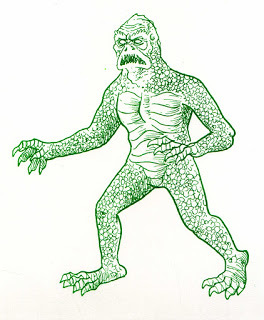 A scaly green 'Creature from the Black Lagoon'-type reptoid (© Richard Svensson)
A scaly green 'Creature from the Black Lagoon'-type reptoid (© Richard Svensson)Laboratory tests later confirmed that something had indeed scraped off the grease from the undercarriage of Wetzel’s car, and several very prominent claw-marks sweeping across the windscreen were readily visible. Although a police search armed with bloodhounds failed to locate the reptoid’s body, and despite suggestions that what he really ran over was simply an uprooted tree, Wetzel never recanted or changed his story.
Almost 20 years later, in 1977, Alfred Hulstruck, a highly respected New York State Conservation naturalist made a startling announcement concerning a hitherto-unreported but highly distinctive alleged inhabitant of the Southern Tier region of New York State, stating: "A scaled, man-like creature...appears at dusk from the red, algae-ridden waters to forage among the fern and moss-covered uplands".
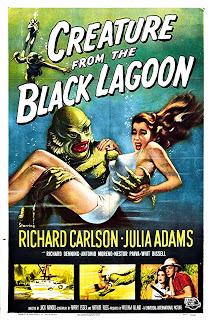 'Creature from the Black Lagoon' advertising poster (public domain)
'Creature from the Black Lagoon' advertising poster (public domain) Outside North America, humanoid lizard men have been reported as recently as 2003 from Italy’s River Po and River Pijava, with plaster casts of their alleged hand and footprints having been made by chemist Sebastiano di Djenaro. And similar entities have also been reported from large ponds or lakes in Poland.
THE MONSTER OF THETIS LAKE – THE TRUTH AT LAST?
The most famous case featuring a Creature of the Black Lagoon lookalike, however, has recently become the most infamous, due to a shocking yet surprisingly little-publicised revelation. It all began on 19 August 1972, at Thetis Lake, near Victoria, the capital of British Columbia, Canada. This is where two teenage youths, Gordon Pile and Robin Flewellyn, claimed to have seen emerging from the lake a bipedal reptoid covered in silver scales and bearing six razor-sharp spines comprising a central longitudinal ridge running along the top of its head. Moreover, upon seeing the youths, the reptoid lost no time in chasing after them, approaching so closely that it supposedly cut the hand of one of the youths with its head’s spines.
Four days later, during the afternoon of 23 August, a similar scenario was reported from the opposite shore of the same lake by two more teenage youths, Russell Van Nice and Michael Gold, who were able to watch the reptoid emerge but without being chased by it this time, because it simply re-entered the water a short time later and vanished. Afterwards, they provided a detailed description of it, which corroborated and added to that of the previous youths. Using this description, a sketch published the following day by a local newspaper depicted the scaly entity with a powerful muscular chest, two three-pronged flippers for feet, clawed humanoid hands, six spines on top of its head, a huge pair of pointed ears, a very large pair of flat fish-like eyes, and an equally piscean mouth.
 Artist's impression of the Thetis Lakemonster (© Richard Svensson)
Artist's impression of the Thetis Lakemonster (© Richard Svensson)Apart from a bizarre attempt by the area’s police to ‘identify’ this entity as nothing more startling than an escaped 1-m-long South American tegu lizard – a species notable for NOT walking bipedally, for NOT possessing ears, a spiny crest on its head, or flippers for feet, but for possessing a striped body and a very long tail (features conspicuous only by their absence from the eyewitness accounts of the Thetis Lake reptoid!) – nothing more was seen or heard of this lake-dwelling nightmare...until 2009, that is.
This was when Canadian writer-illustrator Daniel Loxton, who edits the Junior Skepticinsert section of the highly-acclaimed quarterly science-education magazine Skeptic, decided to reopen this mystifying case. What spurred him on was his discovery that the very weekend before the first alleged reptoid sighting at Thetis Lake back in August 1972, ‘Monster from the Surf’ (aka 'The Beach Girls and the Monster'), a low-budget sci-fi film distributed by U.S. Films originally released in 1965, and featuring a scaly ‘Creature from the Black Lagoon’ type of monster, had been screened not once but twice on local television in this same area of British Columbia. Furthermore, the monster in it perfectly matched the descriptions of the Thetis Lake reptoid that had been given by the teenagers claiming to have encountered it.
 Advertising poster for 'The Beach Girls and the Monster' (© U.S. Films)
Advertising poster for 'The Beach Girls and the Monster' (© U.S. Films)Determined by now to solve this case once and for all, Loxton succeeded in contacting one of the original eyewitnesses, Russell Van Nice (the first time that any investigator had ever done this), who swiftly confessed that their story was a hoax, that they had indeed watched the film on television and had then simply pretended to have seen its monster in real life. True, the testimony of the earlier pair of teenagers has not been exposed as a hoax, but as their description of the Thetis Lake reptoid also corresponds perfectly with that of the monster in the film, it is evident that this reptoid case can no longer be taken seriously.
Yet even without the backing of its most widely-publicised case, the mystery of amphibious reptoids reported across North America remains - thanks not only to those other cases documented here but also to a number of additional ones on file. Prominent among these is an extraordinary case reported from Loveland, Ohio.
HAS THE FROG MAN OF LOVELAND HOPPED OFF?
Bearing in mind that its two separate eyewitnesses were both police officers, the so-called Loveland frog man has attracted more than a little curiosity down through the years. At 1 am on 3 March 1972, as policeman Ray Schocke drove along Riverside Road towards the Ohio town of Loveland, his car’s headlights illuminated what he initially thought was a dog – until the creature stood up on its hind legs, revealing itself to be a grotesque 4-ft-tall entity with textured leathery skin, a frog-like or lizard-like face, and weighing about 60 lb. After briefly staring at him, the creature leapt away over a guard rail, and moved down an embankment into the Little Miami River. As soon as Schocke reached his station and revealed what he had encountered, fellow officer Mark Matthews drove back with him to look for evidence, but all that they found were some scrape marks leading to the river.
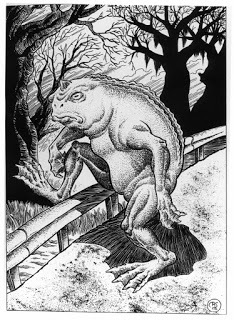 Artist's impression of the Lovelandfrog man (© Richard Svensson)
Artist's impression of the Lovelandfrog man (© Richard Svensson)On or around 17 March, however, while driving alongside this same river just outside Loveland, Matthews himself saw something. Lying on the road ahead was what seemed to be a dead animal, but when Matthews got out of his car to pick it up and put it in the boot, the ‘carcase’ raised itself into a crouching position. Then, without taking its eyes off Matthews, it moved to the guard rail, lifted its legs over it, and vanished. Matthews attempted to shoot the creature with his gun, but missed.
Because there had been reports of weird frog-like entities here in the past, some researchers have suggested that the officers had been subconsciously influenced by these when observing whatever it was that they had seen. Also, in later years Matthews claimed that the media had distorted his account, and that he felt sure that what he had seen was merely a large lizard, possibly an escaped pet. Of course, it may be that the creature he had seen was a totally different one from the entity spied by Schocke. In any event, nothing resembling a frog man has been reported here in recent years, so whether it really was just a case of mistaken identity after all, or, alternatively, Loveland’s most mystifying visitor has simply hopped off to somewhere else, is still unknown.
AN ENDURING ENIGMA
Suggestions that have been proffered down through the years as to what these reptoids might be are as varied and certainly as exotic as the entities themselves – everything, in fact, from extraterrestrial or interdimensional reptilians that have either been secretly residing on planet Earth since ancient times or have reached here from the far-distant future, or Hollow Earth inhabitants that occasionally come to the surface, to evolved post-Cretaceous dinosaurian descendants, or reclusive native life-forms of undetermined taxonomic status but perhaps allied to the equally elusive merfolk and possibly even the bloodthirsty chupacabra.
 Lyle Blackburn with Sheriff Liston Truesdale (© Lyle Blackburn)
Lyle Blackburn with Sheriff Liston Truesdale (© Lyle Blackburn) Far beyond the fringes of accepted cryptozoology, these bipedal reptile-men remain an inscrutable enigma, defying all attempts at explanation or classification. Yet their very existence, if genuine, remains a highly disturbing, disconcerting thought – as eloquently summarised by veteran American cryptozoologist Loren Coleman:
"Are these beasts future time travelers lost in some time/space warp? Or infrequent visitors? Or do you feel more comfortable with the idea there is a breeding population of scaly, manlike, upright creatures lingering along the edges of some of America’s swamps? Something is out there. That’s for sure."
Amen to that!
I am extremely grateful to Richard Svensson for permitting me to utilise his wonderful artwork, and to Lyle Blackburn for permitting me to include his excellent photographs - thanks guys!
And to read about some very different humanoid reptilians - namely, Jake the Alligator Man and the mummified crocodile boy of Topkapi - be sure to click here !
 Taking turns with my mother, Mary Shuker, to display another of my 'Creature from the Black Lagoon' models - click to enlarge (© Dr Karl Shuker)
Taking turns with my mother, Mary Shuker, to display another of my 'Creature from the Black Lagoon' models - click to enlarge (© Dr Karl Shuker)
Published on June 02, 2015 06:42
May 23, 2015
TOPKAPI'S MUMMIFIED CROCODILE BOY AND AMERICA'S MONKEYFIED ALLIGATOR MEN - A CURIOUS QUARTET OF GENUINE FAKES!
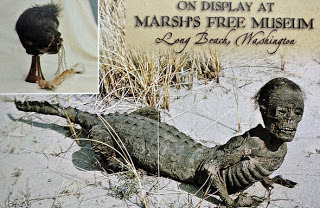 Postcard depicting Jake the Alligator Man (© Marsh's Free Museum)
Postcard depicting Jake the Alligator Man (© Marsh's Free Museum)On 1 March 1992, Turkish archaeologists publicly announced the discovery of an extraordinary Egyptian mummy in the vaults of Istanbul's famous Topkapi Palace Museum during some recent restoration work there. It was concealed inside a wooden sarcophagus (whose form confirmed it as having originated in ancient Egypt), and when carefully unwrapped it was found to consist of the upper parts of a young boy fused to the lower half of a crocodile!
The explanation for this bizarre specimen is still unknown. Some researchers have speculated that the boy may have been killed and partially eaten by the crocodile while bathing (or after accidentally falling) in Egypt's Nile River – and that in order for him to possess a complete body with which to pass into the afterlife, his parents arranged for his reptilian murderer to be killed and for the section of its body corresponding to the devoured portion of their son's to be attached to the boy's remains. However, this theory seems no less grotesque than the mummy itself!
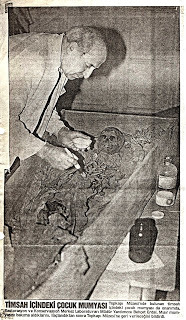 Photocopy of a photograph - click to enlarge - depicting Topkapi's mummified crocodile boy being examined by the museum's Assistant Director of Restoration and Conservation, Behçet Erdal – from a report dated 1 March 1992 in the Turkish newspaper Meydan(© Meydan – photocopy courtesy of Paul Sieveking/Fortean Times via Izzet Goksu)
Photocopy of a photograph - click to enlarge - depicting Topkapi's mummified crocodile boy being examined by the museum's Assistant Director of Restoration and Conservation, Behçet Erdal – from a report dated 1 March 1992 in the Turkish newspaper Meydan(© Meydan – photocopy courtesy of Paul Sieveking/Fortean Times via Izzet Goksu)A more plausible possibility is that the pseudo-conjoined mummy was deliberately created as a sacred artefact or offering by worshippers of Sebek (aka Sobek), ancient Egypt's crocodile-headed god of rivers and lakes. It may even have been produced as a clever fraud for exhibition purposes – in modern times, such specimens are popularly referred to as gaffs; if so, this would make it one of the earliest gaffs ever recorded.
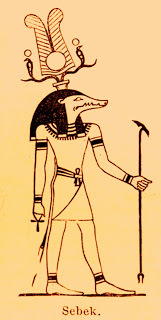 Line drawing from 1885 of Sebek, ancient Egypt's crocodile-headed deity (public domain)
Line drawing from 1885 of Sebek, ancient Egypt's crocodile-headed deity (public domain)As yet, I have not succeeded in discovering whether this unique specimen is on public display at Topkapi. So if anyone reading this ShukerNature blog article can provide me with some relevant details, I'd be very grateful.
Similar monstrosities were once very popular in carnivals and sideshows, especially in America, and at least one such creation still is today. Known as Jake the Alligator Man and constituting the upper half of a monkey skeleton skilfully attached to the lower half of a small alligator, this famous specimen has been on display for many years at Marsh's Free Museum [http://www.marshsfreemuseum.com/] – a thoroughly fascinating, highly-recommended exhibition of wonders and curiosities in Long Beach, Washington (not California, as often erroneously claimed) – and is said to be more than 75 years old.
 Jake the Alligator Man (© imhavingfun42/Wikipedia)
Jake the Alligator Man (© imhavingfun42/Wikipedia)Indeed, every year for almost a decade now there has been an official Annual Jake the Alligator Man 75th Birthday Party held in Long Beach. A short YouTube video of Jake on display at Marsh's Free Museum can be viewed here .
Incidentally, a much more common variant on this particular gaff theme is of course the so-called 'Feejee mermaid' (named after the famous specimen exhibited by American circus showman Phineas T. Barnum in 1842), which consists of the upper half of a monkey sewn to the lower half of a large fish.
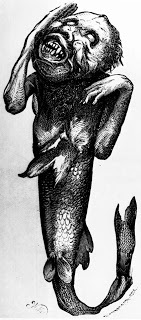 19th-Century engraving of Barnum's Feejee mermaid (public domain)
19th-Century engraving of Barnum's Feejee mermaid (public domain)Jake was purchased by the founders of Marsh's Free Museum in 1967 from an antique store in California, for the princely sum of $750, and was allegedly created by a New York-based firm known as Nelson Supply House. Jake subsequently featured in a series of highly entertaining albeit fictitious reports published by the American tabloid Weekly World News and beginning on 9 November 1993, which claimed that it had been found alive in a Florida swamp!
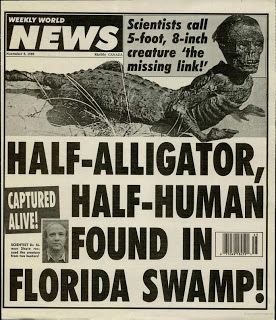 The headline from the first in the series of Jake the Alligator Man reports from Weekly World News (© Weekly World News)
The headline from the first in the series of Jake the Alligator Man reports from Weekly World News (© Weekly World News)More recently, a man named Josh brought a similar gaff into the curiosities shop Obscura featured in the Science Channel TV show Oddities, and sold it to the shop's proprietors for $450. A YouTube video of this interesting episode, uploaded by Science Channel on 1 June 2011 and showing the gaff in close-up detail, can be viewed here .
 The Oddities alligator man (© Science Channel)
The Oddities alligator man (© Science Channel)I also know of a third American alligator man specimen, but, sadly, its present whereabouts are apparently unknown (or at least to me). I have on file a copy of a report from 1996 written by Chris L. Murphy from the organisation Progressive Research, based in British Columbia, Canada. In his report, Chris documented his recollections of what appears to have been an outstanding alligator man, which he encountered while visiting the little town of Seaside, in Oregon, during the summer of 1976. Going into a large general store in the centre of the town, he discovered that it contained a free museum, and exhibited in that museum, housed inside a glass case, was a remarkable specimen labelled as an Alligator Boy. In his report, Chris described it as follows:
"The creature in the case was human looking to about its navel, and the rest of its body was that of an alligator. The human part was "upright," fairly erect as I recall. I studied the creature for a long time and reasoned that it was the body of a child, say about two years old, that had been fused onto the body of a small alligator. The child's body was "mummy-like" in appearance but still had considerable detail. I recall especially its hair, which was very fine and white, very much like the hair one would find on a child of this age, except for the color.
"The process used to fuse the bodies was certainly very exacting. The smooth skin of the child melded in with the scaly alligator skin very gradually, making the creature appear very realistic. I carefully studied the head, hands (which were very small), arms and other parts of the body and reasoned that it would be very difficult to fake something of that nature. In other words, I believe the human portion of the creature was the body of a real child. Unfortunately, there was no literature on the exhibit, and I did not take a photograph of it."
Chris revisited Seaside in or around 1993, intending to photograph the alligator boy, but when he arrived in town he discovered that the general store and its in-house museum were gone, replaced by a clothing store. When Chris spoke to a couple concerning the store and its alligator boy, the man informed him that he'd lived in Seaside most of his life and remembered this specimen well, but stated that some time before the store had closed down, it had been robbed and the alligator boy stolen from it.
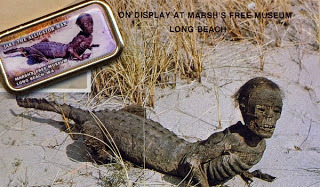 A second postcard depicting Jake the Alligator Man (© Marsh's Free Museum)
A second postcard depicting Jake the Alligator Man (© Marsh's Free Museum)Another Seaside resident, the proprietor of a jewellery store there, informed Chris that there was an alligator man on display at a free museum in Long Beach, Washington (Jake the Alligator Man at Marsh's Free Museum, obviously) and wondered whether this could be the same specimen as the one that had vanished from Seaside's erstwhile store-museum. Anxious to pursue this potential lead, on his way back home to British Columbia Chris stopped by in Long Beach and visited its alligator man. However, he could see straight away that this was a totally different specimen, its body held at an angle, not erect, and, at least in Chris's opinion, of inferior workmanship to the Seaside specimen that he had seen back in 1976. Moreover, he was able to chat with the museum's owner in Long Beach, who confirmed that he had purchased Jake in California (and a decade before Chris had seen the Seaside specimen anyway), and was unaware of any comparable gaffs anywhere else.
Having not seen the Seaside specimen personally, I am reluctant to discount Chris's opinion that it incorporated the head and upper body portion of a real human child, but it does seem more likely that these constituents of this gaff were actually derived from a monkey. Having said that, however, gaffs can be inordinately sturdy (especially if well-constructed), and hence are sometimes extremely old – dating back to times when, whereas albeit entirely abhorrent today, the prospect of such a macabre exhibit having been purposefully created would have been neither unthinkable nor impossible, as exemplified by Topkapi's mummified crocodile boy.
Meanwhile: whatever happened to the Seaside alligator boy? (Not only is it not Jake the Alligator Man, it is not the specimen sold on Oddities either, because the latter's body was not erect in posture but instead was held at an angle, just like Jake's.) Does it still exist today, and, if so, where is it? And are there still other alligator man gaffs also out there? If you know of any, or have any information concerning the presently lost Seaside specimen, please post details here on ShukerNature – thanks again!
 Two Turkish newspaper reports from 1 March 1992 - click to enlarge - concerning the Topkapi mummified crocodile boy, one from Meydan, the other from Hürriyet (© Meydan/(© Hürriyet - photocopies courtesy of Paul Sieveking/Fortean Times via Izzet Goksu)
Two Turkish newspaper reports from 1 March 1992 - click to enlarge - concerning the Topkapi mummified crocodile boy, one from Meydan, the other from Hürriyet (© Meydan/(© Hürriyet - photocopies courtesy of Paul Sieveking/Fortean Times via Izzet Goksu)This ShukerNature blog article is a greatly-expanded, fully-updated version of a short account of mine that originally appeared in my book The Unexplained: An Illustrated Guide to the World's Natural and Paranormal Mysteries (1996).

Published on May 23, 2015 11:28
Karl Shuker's Blog
- Karl Shuker's profile
- 45 followers
Karl Shuker isn't a Goodreads Author
(yet),
but they
do have a blog,
so here are some recent posts imported from
their feed.



